If you’re looking to experience the excitement of pike fishing on a new venue – here’s a guide to targeting these “freshwater barracuda” on rivers, lakes, reservoirs and more.
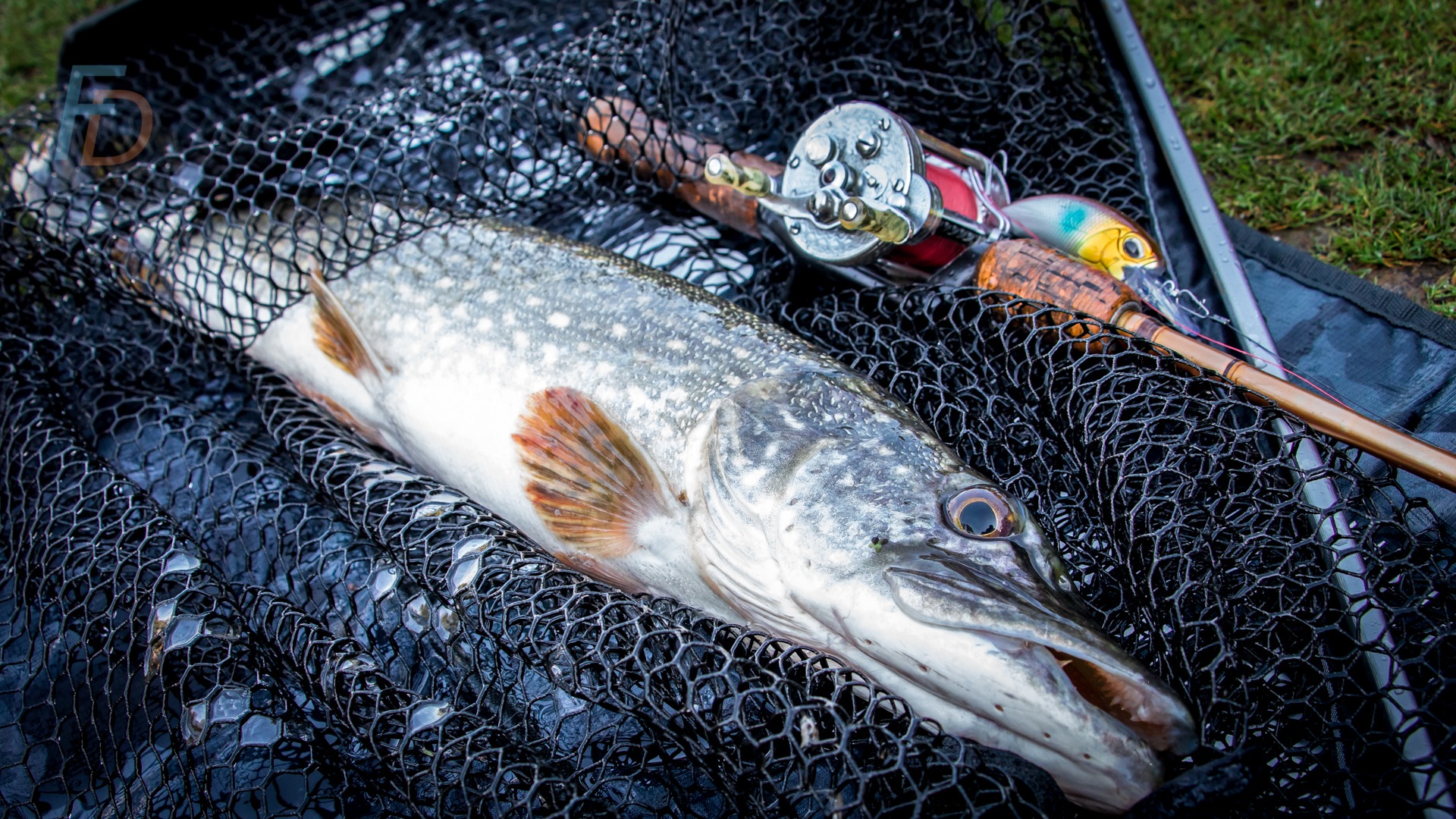
In Pike Fishing C&R – Fish Care is No.1 Priority
Before getting into gear & tactics to land fish, you need to be prepared to unhook and release pike safely. Out of the water, they are one of the most delicate fish around. Essential kit, therefore, includes:
With pike of any size – though especially with large fish – avoiding crushing the internal organs is essential. The image to remember is that of a long, water-filled balloon. When held in the water, there is hardly any strain on the external skin or the internal liquid. Imagine the pressure you’d need to put onto the points where you’d grip a 3-foot long water balloon with each hand. It’s not too much different to how much pressure you’d be putting on a pike if you tried to hold it under the belly and lift it out of the water. The heart on a pike is not far behind the back edge of the gill covers – so it is very easy to get a hand in the wrong place and crush that vital organ…
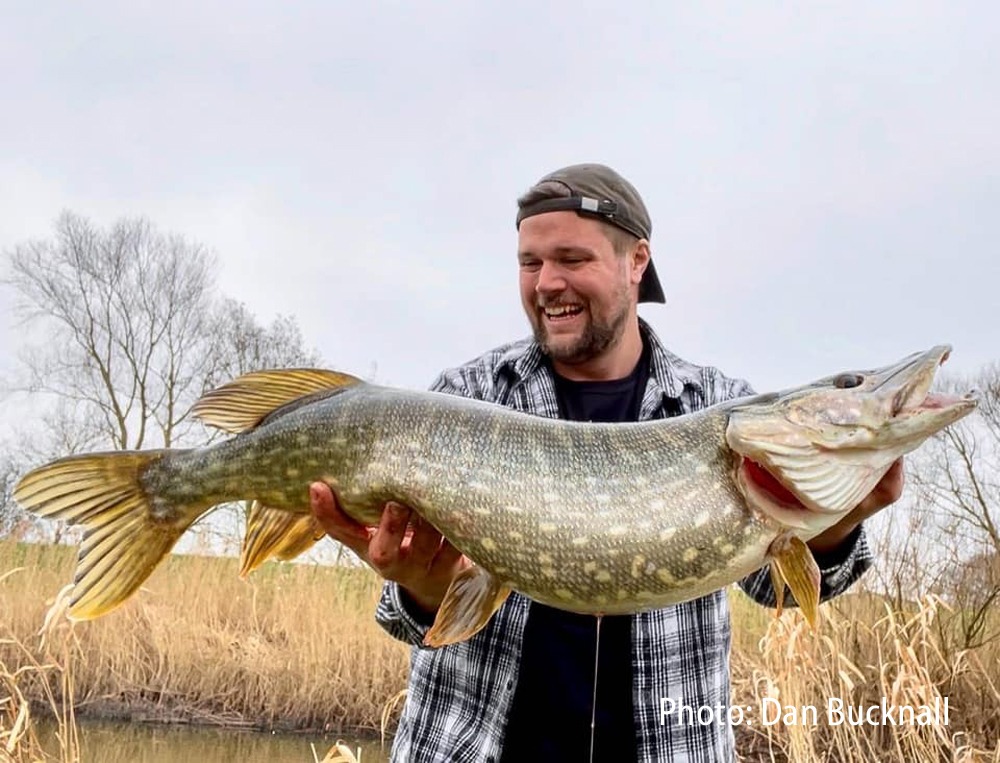
Dan Bucknall (Insta: @db_fishing_) using a good gill-plate grip and kneeling over a mat for a quick photo (image by permission)
Probably a safer bet would be the CAREFUL gripping on the hard, bony surface of the inside of the gill-plate, under the “chin” of the fish is a better option.
WARNING: While doing this you need to keep your fingers out of the gill-rakers and especially the gill filaments of the fish. It is not a case a jamming your fingers into the fish’s gills! Instead, carefully work your fingers along the hard, smooth plate and don’t shove your fingers deeper into the gill structures themselves.
If necessary, be prepared to cut the hooks off your trace (or snip the points of your hook(s) off so they can be removed) in order to release a pike safely.
It is an absolutely vital part of pike fishing to prepare for managing and unhooking a fish BEFORE you hook one. Minimising the time out of the water, resting the fish in the net BEFORE unhooking it if the fight has been hard and not holding the fish high off the ground where it could thrash free of your grip are all good basics. If necessary, get an experienced pike angler to accompany you and show you the ropes.
How to Make Great Wire Traces for Toothy Predators
Although stainless steel is the cheapest bite-proof wire, the rate at which stainless traces curl and crinkle up following a fish capture or encounter with any kind of snag can quicky rack up the expense. That means going to the extra initial expense of a titanium wire can, weirdly, save you money. It is also hard to put a price on the extra confidence you get from knowing there’s a much better chance your presentation is on-point since the last time you checked your trace.
NOTE:
Use braided titanium wire for when you need a supple trace, or single strand for specialised “stiff” leader presentations (see the lure fishing section below).
You can buy ready-made traces – though the ability to fine-tune exactly what you want means that it is worth learning to make your own.
As well as wire, there seems to be an increasing amount of experimentation with using super-thick fluorocarbon (borrowed from big-game sea fishing) for bite-proof traces too. I’ll look to report more on this in future, though I can certainly see potential benefits for methods such as topwater lure fishing.
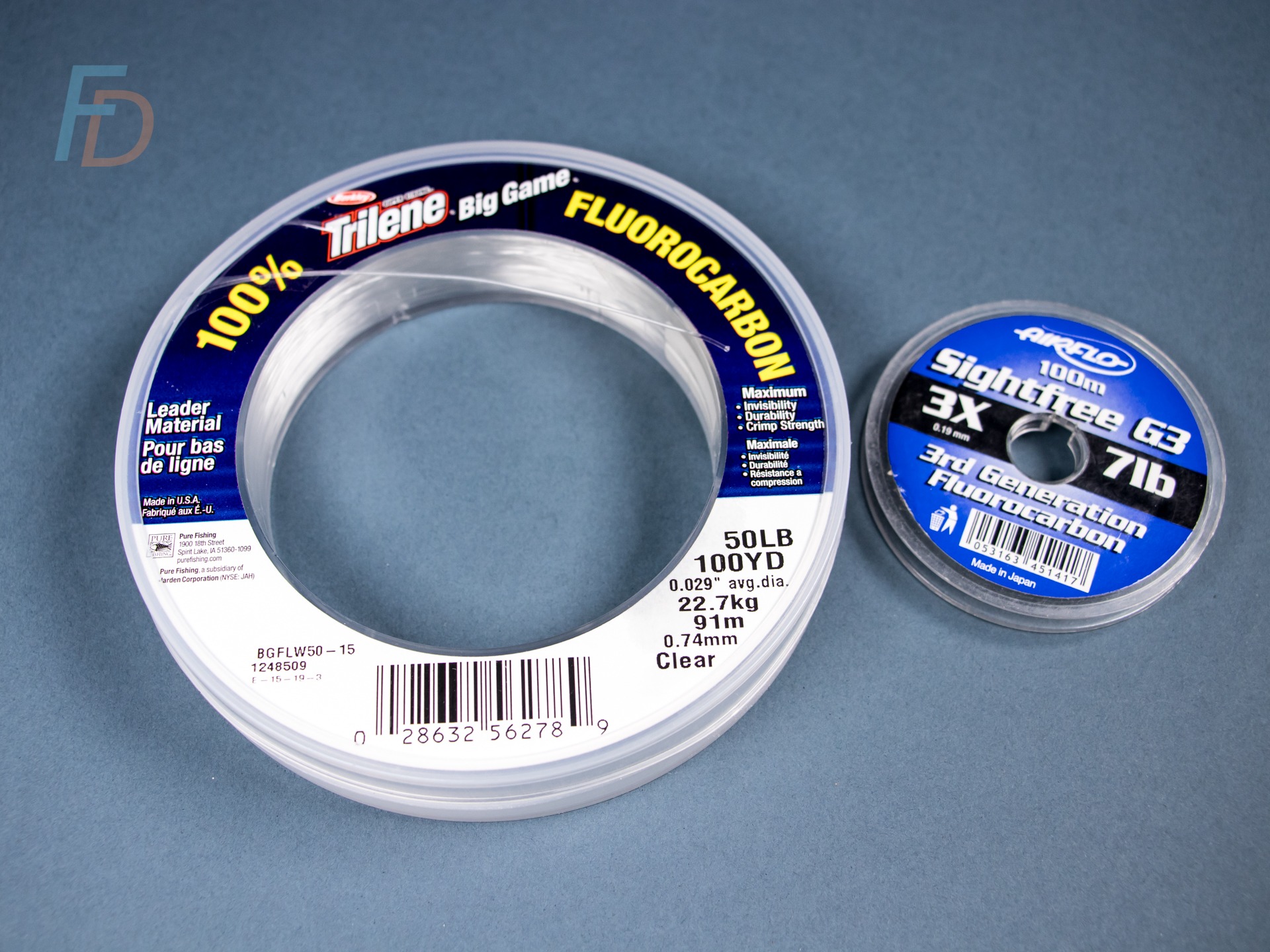
Fluorocarbon in the 50lb (e.g. left), 80lb or 100lb class is used by anglers around the world for toothy predators (including pike)
That being said, it seems essential to frequently check fluorocarbon traces for any signs of fraying (and replace immediately if found).
Whatever main-line you end up using on your reel, you’ll always need a bite-proof trace for pike fishing…but what about that reel line?
Best Fishing Line for Northern Pike
Even for relatively small pike (and if restricted to affordable nylon monofilament line), you would want to use mono of at least 12-lb breaking strain – simply to have a good chance of standing up to the strains of casting and pulling out of at least some snags.
However, with the creation of modern PE braided lines, it is now possible to have a really high breaking strain with a way lower diameter line (which also has pretty much zero stretch). There is nothing “sporting” about deliberately using a line that is too weak and leaving hooks in a fish.
Instead the limit on force when playing a fish should be a combination of your rod’s power, reel-drag and avoiding pulling the hooks free from a big fish. On that point, the rod and reel-drag should be strong enough for the fish you can reasonably expect to hook.
Although they look scary, the Northern Pike is a delicate fish – particularly out of water. Playing a pike for an excessively long time is not a good way to ensure survival after you release it.
The “best” line for pike fishing will depend on the method you’re using. Let’s start with methods benefiting from low stretch line. This, to me, says you should be using braid.
Pike Fishing Braid
For the flexibility of either float fishing or legered deadbait applications, a neutral buoyancy braid (for instance 65-lb Power Pro) will be a dependable choice. While the extra diameter of 60lb-plus braid can help in controlling the float, for some ledgering applications you might want to go somewhere between 40lb and 50lb for ease of cutting through the water and creating contact to your terminal tackle.
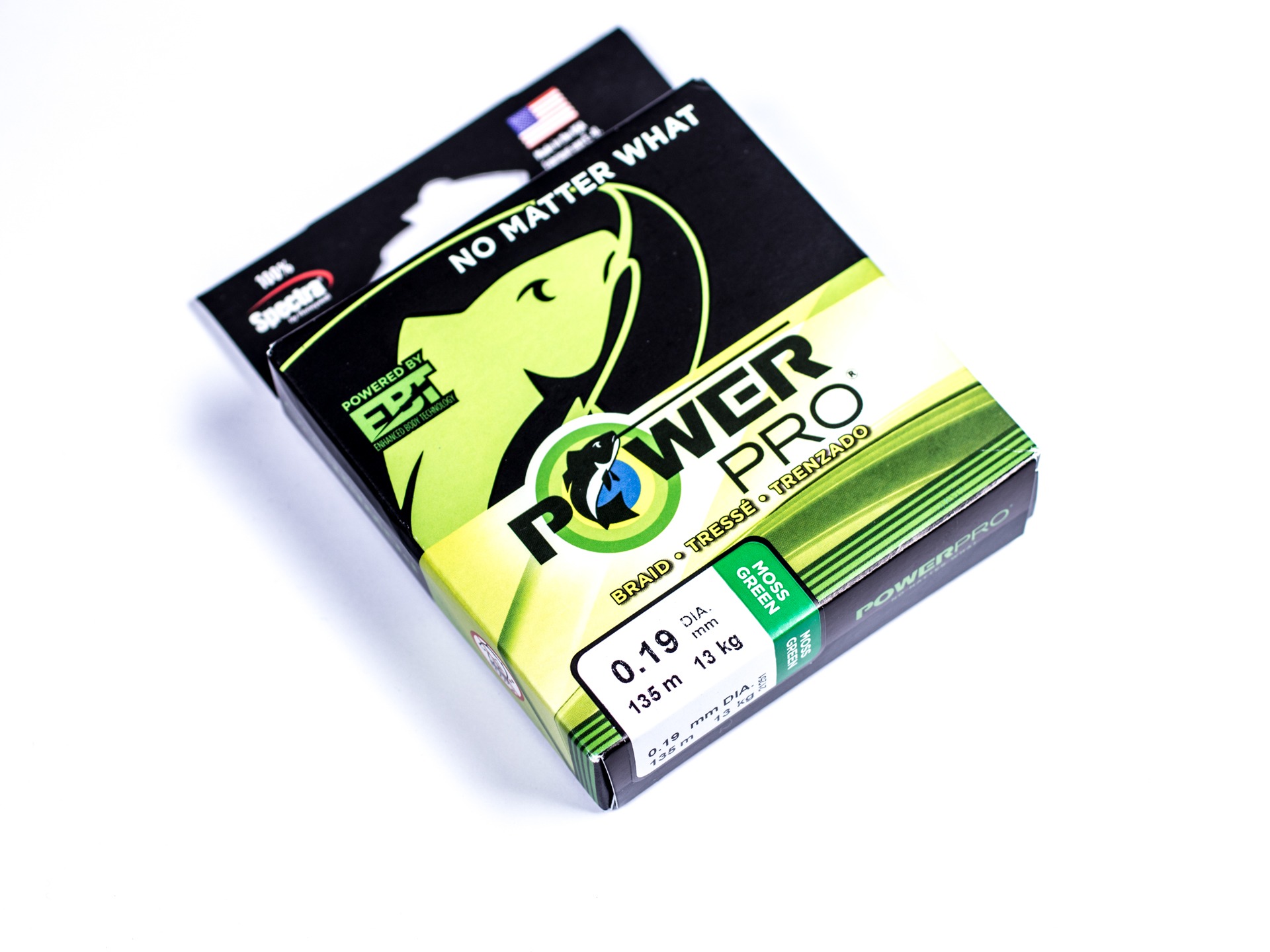
For lure fishing, matching the strength of the braid to the weight of the lure, how snaggy the water is and the size of fish are all important factors. For most “pike” sized lures, this will mean braid in the 30lb to 50lb range. For lighter, more finesse lures and jack-pike fishing, braid somewhere around 20lb could be an appropriate option.
The two factors which can put people off using braid is the expense (relative to nylon monofilament) and also how easily it can be cut by sharp or abrasive snags. All of a sudden, that 50-lb breaking strain drops to zero after a tight-line contacts a rough edge. This seems to be related to the much finer individual fibres (and possibly the reduced overall diameter of the finished line). I expect that this accounts for the greater abrasion resistance of 4-strand braid compared to 8-strand for example.
However monofilament is literally single-strand…
Pike Fishing Mono
These days anglers tend to say “Mono” specifically to mean “Nylon”, even though technically any single-strand fishing line is “mono-filament”. Whether that filament is fluorocarbon, nylon or copolymer, it is all really “mono”. When it comes to any monofilament line – of any material – there is huge variation in physical characteristics between different brands and products within that same material. It all depends on the details of the manufacturing process.
You will probably find almost as many recommended brands of nylon mono as there are anglers - with some folks swearing by Berkley Big Game, others Ultima Sea Strike, still more perhaps Daiwa Sensor or traditional options like Maxima Chameleon. In reality, all of these brands and options should serve you pretty well. It is more a case of finding the appropriate strength and diameter for your needs. The minimum breaking strain for nylon mono when targeting pike would probably be 12lb - and a likely maximum of 20lb - with most people opting for something in the 15lb-18lb class.
The one consistent thing is that fluorocarbon will have a greater density than nylon – and in “pike fishing” breaking strains, this will tend to make it sink more quickly and can be useful for creating that “contact” to your rig when fishing ledgered baits. While fluorocarbon is often reported to have lower stretch than nylon, in practice this may not be true. Again, I suspect that stretch varies a lot between different formulations and manufacturing processes within – as well as between – those materials.
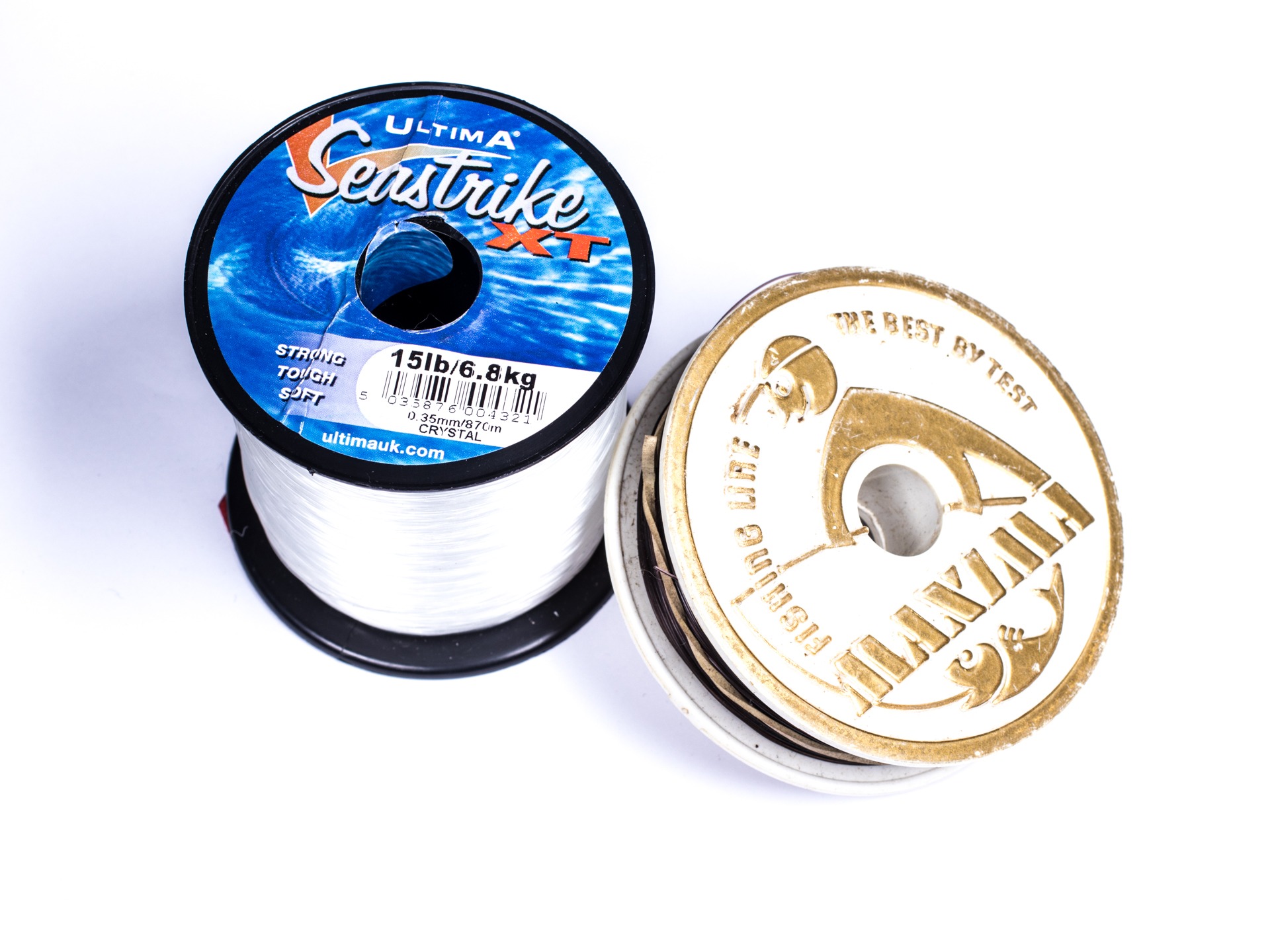
Similarly, when comparing notes with my angling buddies, we find that – in general – nylon lines seem to have greater abrasion resistance than fluorocarbon lines under “field conditions” (regardless of what the on-paper performance should be). This is another factor that could be surprising when looking at the advertised properties of fluorocarbon. For me, if abrasion-resistance is the reason for choosing an alternative to braid, I would have more confidence in nylon.
Whether fluorocarbon or nylon, there can be some other less-well-known exceptions to the “non-stretch braid when pike fishing with lures” guideline suggested above. A particular example is when deliberately casting lures into weed-beds and other cover (using heavy line, strong tackle, heavy-wire hooks and sturdy weed-guards on those hooks). The extra stretch – compared to braid – of monofilament lines can produce a different presentation of the lure when it pulls free of a snag.
With braid, when the lure pops off the snag, it will tend to stop or stall because of the non-stretch character of the line.
For monofilament with more stretch and rebound, the lure can continue to “swim” out of that snag for several feet.
On it’s day, that difference in presentation may trigger more strikes than the lesser movement created with braid (and vice-versa).
Finally, when targeting pike on or near the surface and when they are in full fighting, leaping and tail-walking mode, a line with more stretch and rebound can be better at keeping those hooks pinned. A non-stretch line with a stiff rod is more likely to allow a wildly-thrashing fish to create slack line and throw the hook.
Although personal experimentation is the best way to success, a decent starting point should be a well-established product like Berkley Big Game or Maxima in the 17 to 20-lb range, depending on size of baits, snags and size of pike.
In the end, there is no substitute for one of the central mottos of Fishing Discoveries:
Once you know the end effect you’re looking to create, it is easier to work backwards and design the tackle and rigs to best support that result.
For your own venues this could include experimentation with different braids, monofilaments and breaking-strains. Hopefully there are some good starting points for that experimentation given here.
Best Pike Fishing Reels
The sheer variety of gear available these days is both a blessing and a curse. It is fantastic that there’s such a good chance you can buy the ideal piece of kit – with good choices at all price-points. At the same time, if you’re not sure exactly what a good basic option would be and someone recommends a product that isn’t easily available in your area, then all that choice can be overwhelming.
Probably the most useful thing I can do at this time is to offer some specifications to look for along with the reasons behind them. That way, you can do a sense check to see if those specifications are a good fit for your fishing.
Reels for Pike Fishing with Deadbaits (or Livebaits)
The best all-round bet for fishing the relatively large, natural fish used in either deadbaiting or livebaiting will be a specialist fixed spool reel (sometimes also called spinning reels). Due to the stresses of casting heavy, natural bait, the distances involved and the high breaking-strain of the line associated with pike fishing, reels in the 6000 to 12000 size-range are recommended. The larger the number, the more line capacity – so it is a case of matching your likely fishing range and preferred line diameter to the reel size.
Borrowing from the world of modern carp fishing, the reels now known as “Big Pit” models are often very well suited to fishing for Northern Pike. The longer spools with high line capacity and better line-lay are very handy features to have when bait-fishing for pike. Quite often Big Pit reels do not have a baitrunner or free-spool function.
Baitrunner designs allow the spool to rotate at a pre-set low drag pressure during a “run” when a fish picks up the bait – but kick into the full drag setting as soon as you turn the reel crank (or flip a lever). Here is a good overview of typical functions in this style of reel:
The choice of bite indication covered in the coming sections will determine whether or not a baitrunner function is particularly useful for your pike fishing. Generally speaking, though, baitrunners are far less important for pike than they can be in modern carp fishing. Instead, good line-lay with sufficient capacity and also robust construction to stand up to the high strains involved are much more important.
Lure Fishing Reels for Pike
Even a small pike can – and will – happily attack what would otherwise be considered very large lures for most other species. This is covered in more detail further on in this article – but given the number of cast-and-retrieve cycles involved with fishing lures for pike; a baitcasting reel can have big advantages over the kind of reel recommended for bait fishing above.
The use of your thumb to control the release-point during the cast is also a lot less painful over time compared to high-breaking strain line ripping from under your index finger on every one of those multiple casts!
With small lures (or fishing styles with fewer casts), this isn’t an issue – but it could get annoying fast during a hard day throwing big lures hundreds (maybe even thousands) of times.
OK, there could be a slightly bigger speed-bump to get over with your skills when first picking up a baitcasting reel compared to a fixed spool (spinning) reel. With that said, if you’re casting lures of say, 15-g right up to even 150-g+ on a well-balanced baitcasting rod and reel, it really isn’t too hard to get to grips with.
The key skills of setting the brakes, spool-tension and stopping the spool at the end of the cast are covered in my how to cast a fishing rod guidelines.
Until quite recently, getting hold of a good baitcasting reel would tend to be a pretty costly exercise. Nowadays, whether it is Walmart, Aliexpress or other discount supplier, there are some really affordable reels that will give you a good experience. For instance, I have been really happy with the Piscifun Alijos (above) for fishing big swimbait lures at a steady pace – particularly in winter (that reel is also available in a much higher gear ratio for “burning” baits back faster; pictured below). In fact, I've enjoyed using it so much I've now added my affiliate link to this reel in its different gear-ratios and left/right hand wind models to this article:
Fantastic options exist at price points above this too. Whether it is sheer build-quality, smoothness or even computer-controlled Digital Chip (DC) casting-brake systems and top-end Japanese engineering; your dream baitcasting reel is probably out there already.
Maybe now is the time to give one a go if you haven’t before?
Don’t forget, for medium-sized pike and larger, the entry level pricing for a suitably robust spinning reel is going to be very similar to a baitcasting reel that can do the job well in a much more compact frame.
To get ahead of the game with lure fishing tactics that put more pike on the bank (or boat) - try adding the skills covered in my Free e-book:
Converting interest into strikes...
Turning interest from a pike into a fully-committed strike relies on a combination of what you throw and how you work it. Inside this guide you can discover some of my favourite ways of achieving that goal
Just Click Here or on the Book Image/Button below to register for your Free Copy - plus 5 bonus fishing secrets in an exclusive free Email Series:

The main specifications to look for will be sufficient line capacity, enough drag-pressure and then matching the gear-ratio to the style of lures (and speed of presentation) you’ll be using the most. On that last point, it tends to be easier to make a “fast” (high gear-ratio) reel perform a slow retrieve than it is to make a “slow” (low ratio) reel burn back a lure at a fast pace.
For drag pressure and performance, it may be well worth checking out Deuthlon Power Drag Grease (especially as part of a starter pack).
Don’t forget that the spool diameter in combination with gear ratio actually determines how much line is pulled in per turn of the crank. For that reason, it can be handy to check out the length of line retrieved per handle turn and not only rely on the gear ratio to judge the speed of a baitcasting reel.
Fly Reels
Fly fishing is, for whatever reason, often put on something of a pedestal. Perhaps it is funny that the reels needed for this style have much less complex engineering requirements than the other styles featured here.
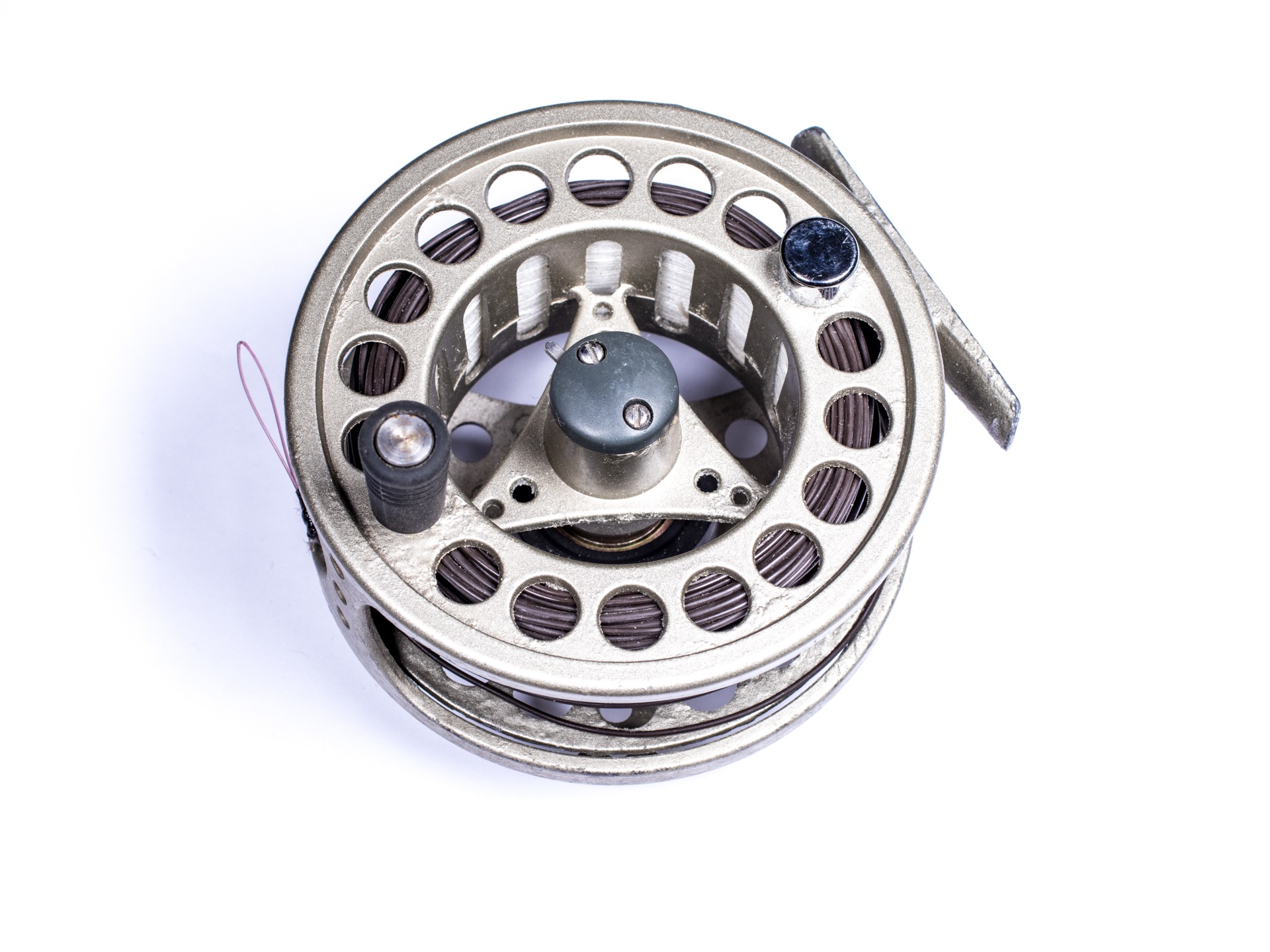
My "well loved" (i.e. battle scarred) Vision Koma large arbour fly reel which sees duty in saltwater fly fishing as well as for pike on the fly
The main requirements of a reel when it comes to targeting pike on the fly is that it has enough capacity to easily carry ample backing plus the high AFTM rated fly lines needed to cast big flies. Additionally, a half-decent drag will be useful when a large pike takes line. Fly reels commonly used for saltwater fishing tend to be ideal for the purpose.
Best Pike Fishing Rods
Just as with all the other gear recommendations in this article, I want to avoid tying you down to ONLY specific models or brands for pike fishing rods.
Again, by explaining what each of the different specifications does to support your chosen fishing approach, you can gain confidence in matching any rods available to you with the listed specifications you need.
It puts you in the driving seat, rather than being forced to rely just on a short-list of models that I happen to like (or know about).
With such a range of tactics available for targeting pike, it is probably not a surprise to hear that the ideal rod will vary for each approach. Also, the size of bait/lure, size of pike and the venue will also determine what you need from a pike rod. Let’s take a look at some different scenarios...
Deadbait/Livebait Pike Rods
With these tactics, even relatively small baits tend to be pretty heavy – at least compared to many other freshwater bait-fishing methods. This means there usually needs to be a fair amount of stiffness and power to your ideal rod. Rigs for live and deadbaits also tend to mean you have more line outside your rod tip (in other words a longer “drop”) when casting – particularly when using rigs that include floats and up-traces.
While fishing from a boat could make a slightly shorter rod less cumbersome, you are still probably in the 9 to 10-foot range as a comfortable length.
As well as the rods - check out super-experienced pike angler (and author of "Tangles with Pike"; https://dgfishing.co.uk/shop/) Dominic Garnett's deadbait rig, drop-off indicator and front alarm system below. This could be a useful preview before we get to those things later in this article!
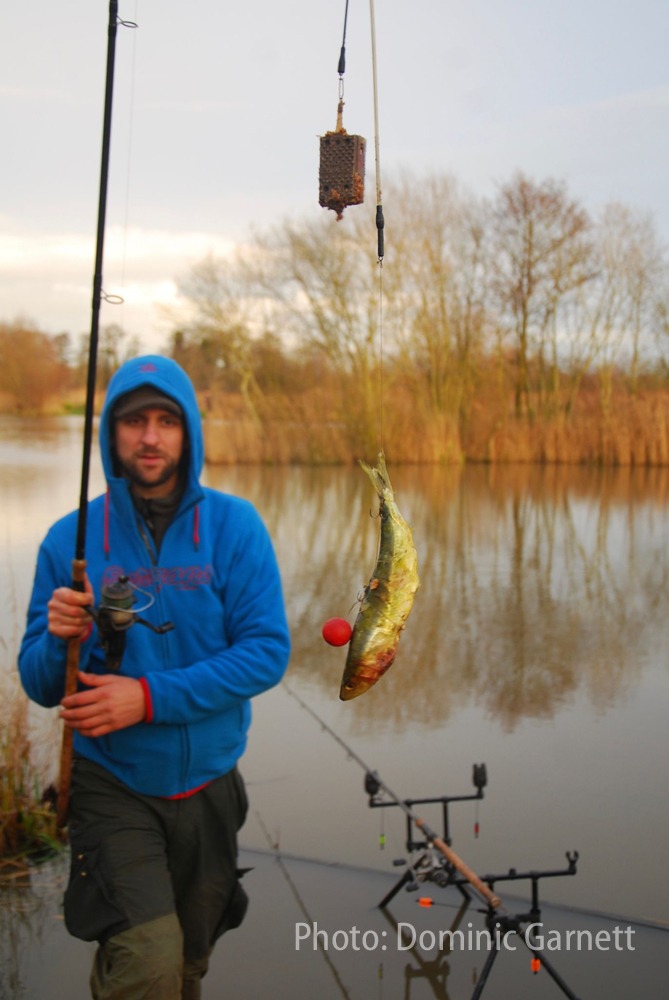
Stout rods in the 10 to 12-ft range are ideal for pike fishing with dead baits: DG Fishing
Bank fishing very often combines a need for longer casting and the ability to reach over the top of marginal vegetation. Both those factors favour a longer rod – with 11-12 feet being usual (and 10ft possible depending on the venue).
For small to medium-sized baits – say 3” to 6” in length a rod with a test-curve of 2.75lb will perform well. For you folks who are more used to rod ratings of M, MH, H etc. the test curve rating of a rod is how much weight you need to hang from the tip in order to form a 90-degree angle between the butt and the tip.
For medium to large baits (5” to over 7”) or just for casting further on really big venues, a rod with a test curve between 3lb and 3.25lb is probably best.
Because these are matched to fixed spool reels (and given test-curve ratings) – it could be difficult for North American anglers to find rods designed exactly like this. Perhaps looking at heavy spinning rods, carp rods (or maybe even surf fishing rods) in the 3.3 to 3.6-m range capable of casting lure weights between 100g and 200g on Aliexpress could turn up useful results.
While I have zero in-person experience with this rod (and can’t vouch for it in any way!), the following rod might be worth checking out via my affiliate link given the pricing and specifications:
Lure Rods for Pike Fishing
Lure fishing for pike can be super rewarding while targeting pike of all sizes across the spectrum – from as small as 1lb up to 20lb-plus. What is classed as a big pike will completely depend on your chosen venue. Canal pike can run to large sizes, though often fish in the 8lb to 12lb range will be a really good fish. River pike could be pretty much any size – and large stillwaters (either natural lakes or man-made reservoirs) tend to hold some real giants.
Again this poses the usual challenge of recommending a single “best” pike fishing rod when using lures. It completely depends on your lures and target fish sizes. Soft plastic lures matched with jig-heads or mounted on Cheburashka style rigs with offset, wide-gape hooks can give a relatively large profile lure for not a ton of weight. Because of this, you might find yourself fishing soft plastics on jig hooks for canal pike with something as delicate as a spinning or drop-shotting rod rated for lures between 5 and 15-g…
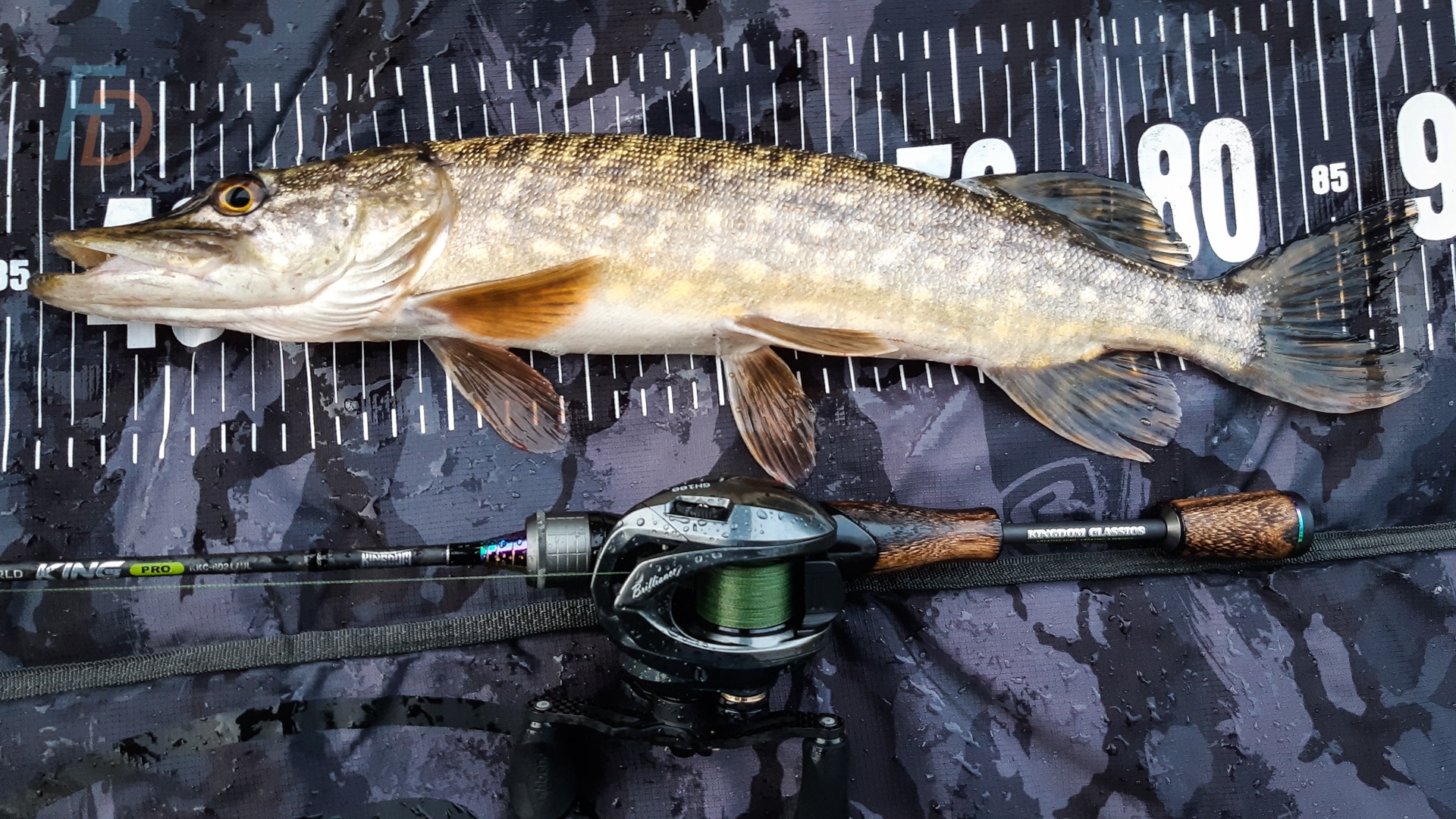
Small jack pike on BFS rod rated for lures between 2 and 12 g (laid on a wetted pike mat)
Similarly a “power BFS” style rod and reel capable of handling lures in that 5 to 15-g range would be the finesse baitcasting version of that approach. Both of these set ups could also be used to throw hard crank baits in the 9 to 15-g range.
However, something that is closer to normal for pike fishing with lures would be a spinning or baitcasting rod (matched to the appropriate reel) of between 7 and 10-feet in length and rated for lures in the 10 to 45-g range (MH to H).
With all that said, don’t ever forget that even a small jack pike can (and will) happily take a big lure. Relative to the width and depth of the body, a pike’s mouth is absolutely massive. This means that your go-to pike lure rod could well be rated for lures in the 80 to 170-g range (H to XH) and maybe be between 7 and 9-feet long. Anglers who prefer to use the rod tip (rather than reel-cranking) to jerk their baits and make them kick out sideways or body-roll may do better with a shorter rod. That is particularly noticeable for heavier baits where a longer rod might flex too much to impart a strong jerk to the lure.
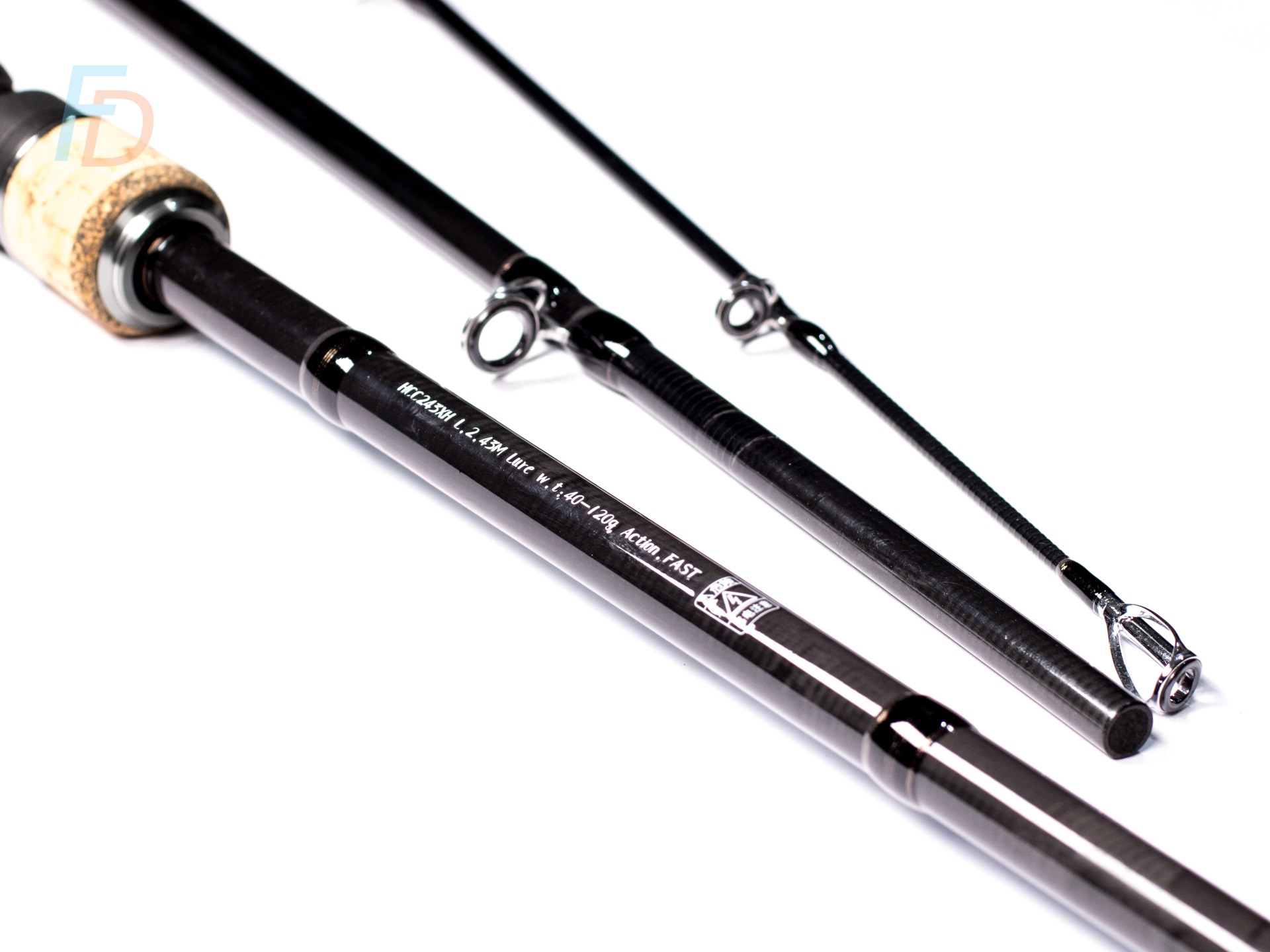
Fast action and rated for lures between 40 and 120g (and available in lots of different ratings) - a highly affordable Obei Hurricane rod
With the above rod available in so many different ratings (I currently own two different models) and exceptionally affordable pricing it seems useful to include my affiliate link for it here:
As mentioned in the reels section, when it comes to lure fishing for pike, I feel there is a significant advantage to using a baitcaster. For this reason (with the exception of the dropshotting rod) all of the rods I have in mind here would be baitcasting rods.
If you are a committed fixed spool/spinning reel-user, then the same broad characteristics would apply – just with different designs for reel seat and line guides!
Fly Rods for Pike
When fly fishing for pike, the main consideration is to be able to apply enough pressure to the fish to keep the fight as short as possible. Depending on the size of pike in your water, this probably means rods rated in the AFTM #9 to #12 range and around 9-feet in length.
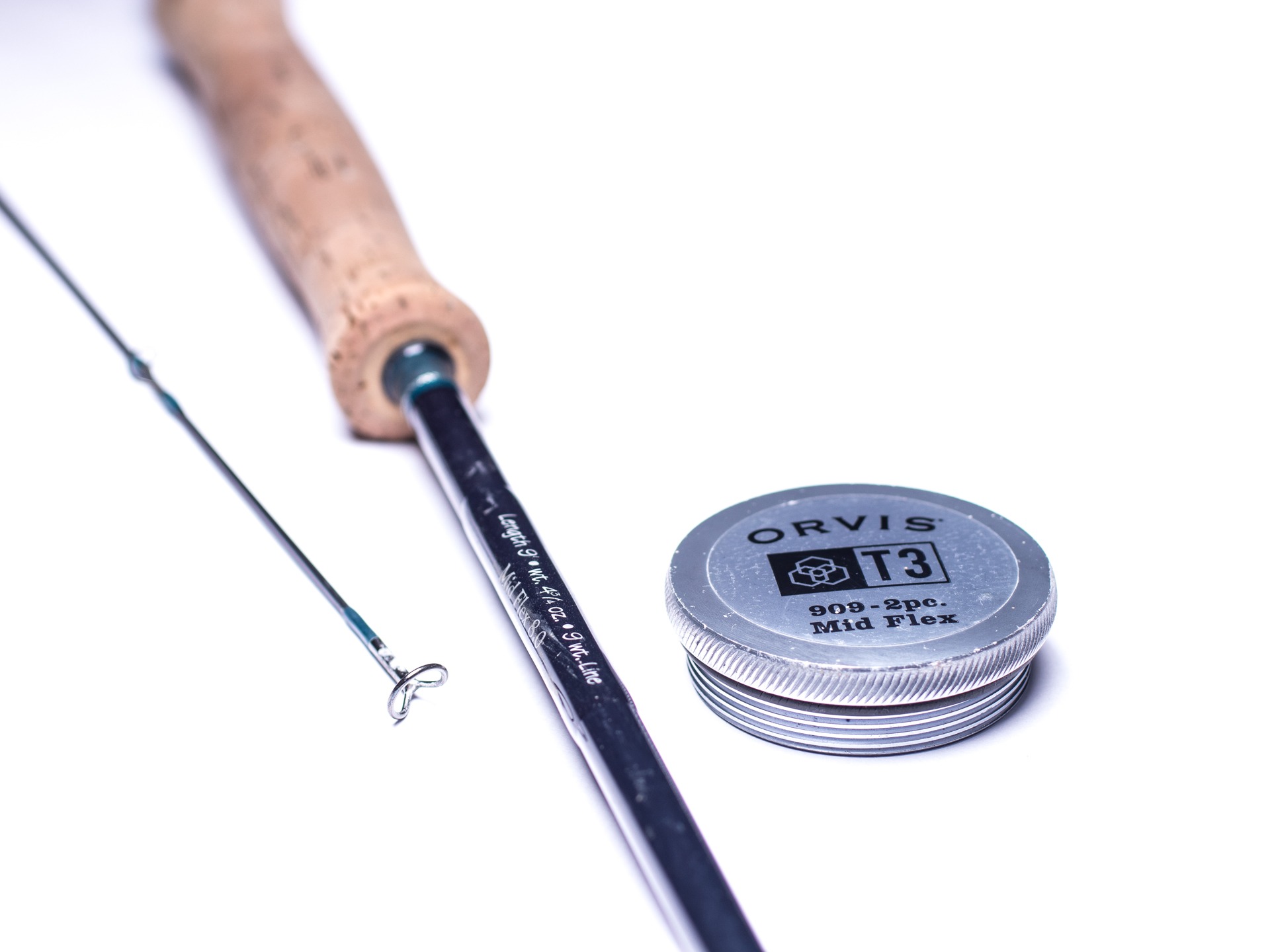
My equally loved/battered 9ft AFTM#9 T3 by Orvis
The by-product of choosing rods strong enough to land pike quickly is that they will automatically be suited to throwing the generally pretty large flies you’ll want to use. As well as dedicated “pike on the fly” rods, you might want to look at some of the saltwater fly fishing rods for this purpose.
Deadbaiting for Pike
In the UK, this is a very typical approach through the colder months of the year. The technique can be broadly divided into float fishing and legering (or ledgering) variations. On the subject of legering for pike, both spellings of the word seem to be in use, so I’ll try to use both in this article. Anyway, back to the fishing… Since we already know from the sections above what our rod, reel and main line is likely to be, here I can concentrate on rigs and tactics.
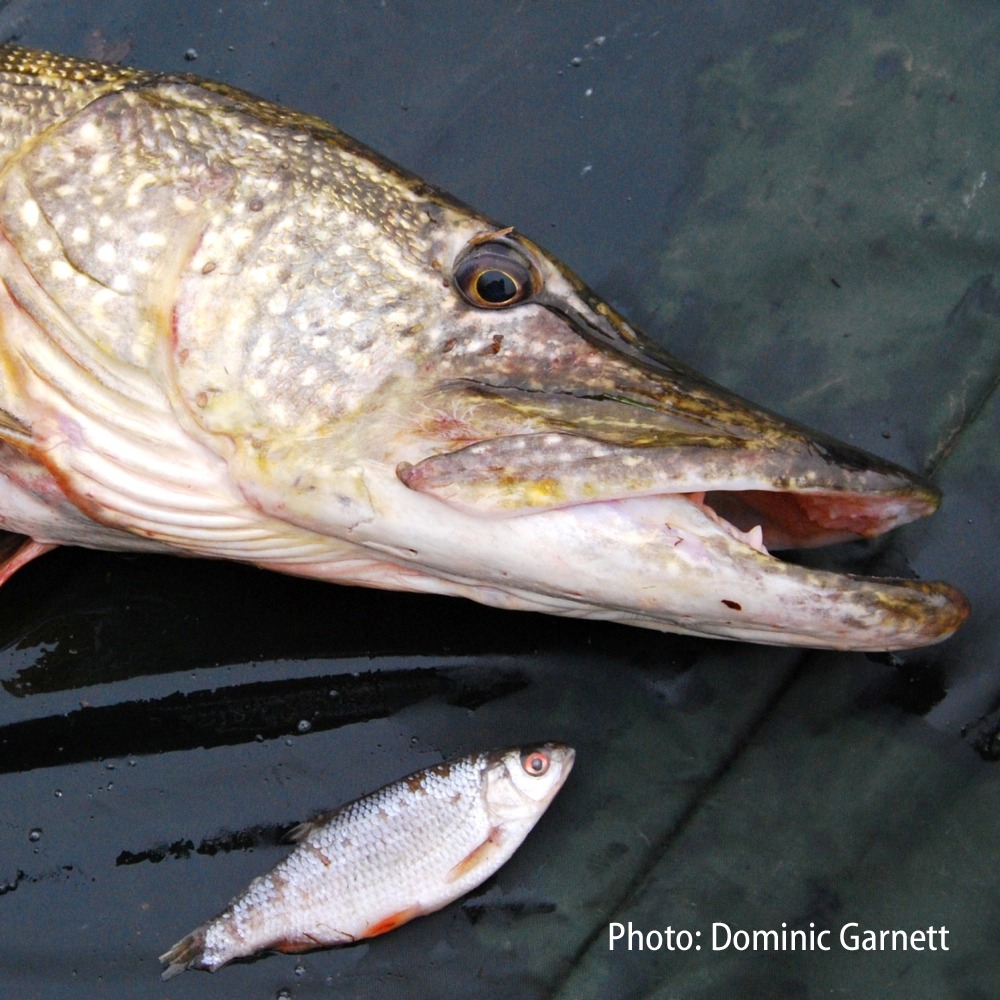
A big pike coughing up a roach deadbait for Dominic Garnett at DG Fishing
Baits could be either freshwater fish or sea fish – with roach (e.g. above), skimmer bream, lamprey-section, pollan, smelt, mackerel (either whole or half), sardines and herring all being popular and effective options. Good tackle shops will have a supply of frozen baits available – but any food-market that sells such fish blast-frozen immediately after capture will provide excellent baits.
Let’s look at presenting some of these baits.
Float-Fished Deadbaits for Pike
This is a great method for all kinds of waters – including lakes, reservoirs, canals and rivers (in fact pretty much anywhere pike can be found). The use of a float means you can quickly experiment with presenting your bait at a range of different depths. Suspended baits can also be drifted with the wind or river current to search more water than static presentations.
An outline of the rig would be a sliding float with a bead above, butting up to a float stop on the main line. Below the float will be a buffer bead and then a swivel (attached by Palomar knot) to an “Up-trace”. The bottom of the up-trace has an egg-sinker and ends in a quick attachment snap swivel. Then the terminal trace (carrying the hooks) attaches to the snap.
Check out the diagram to see how to construct the float rig with up-trace:
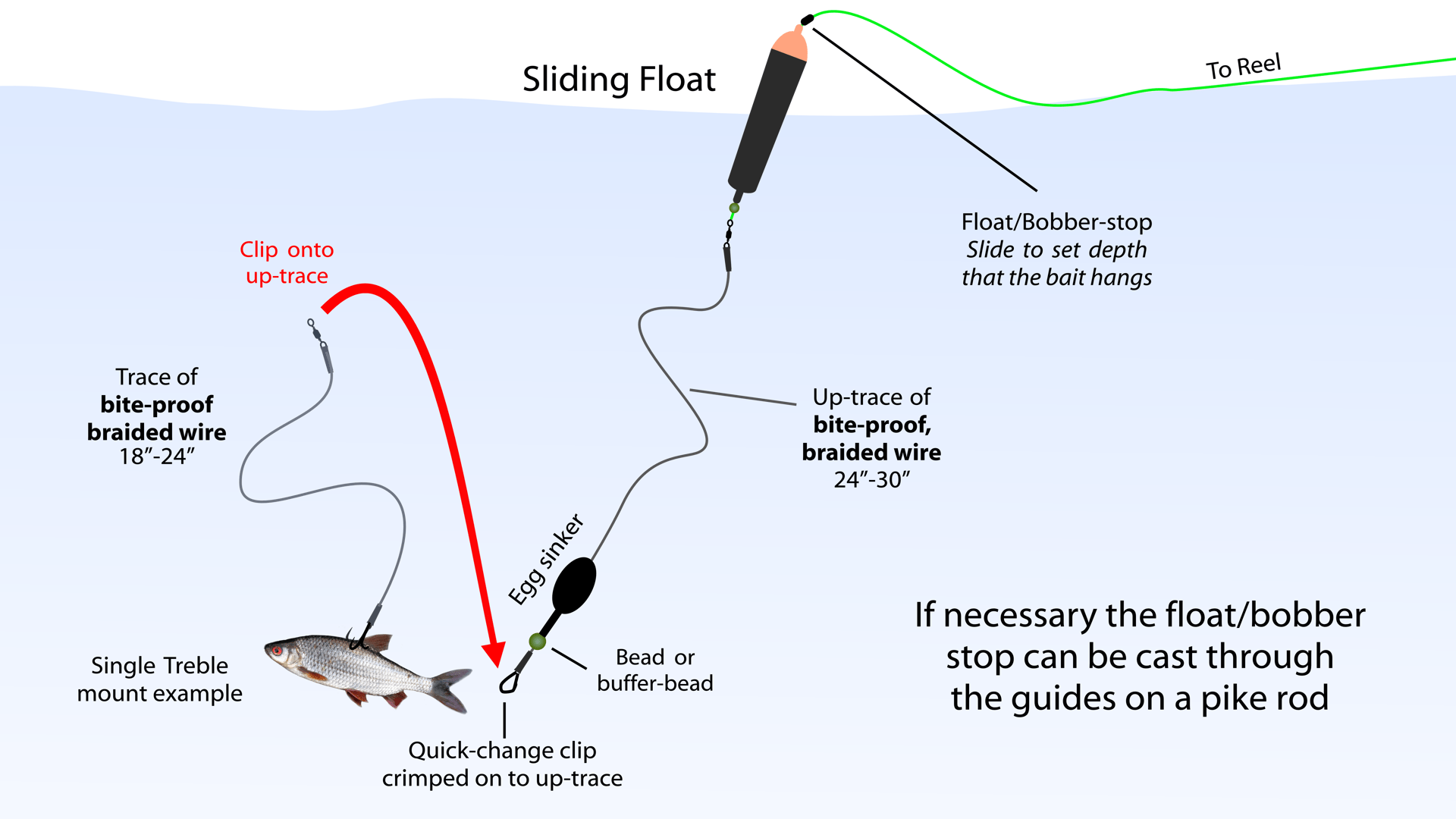
The reel line is threaded through the centre of the float and tied to the up-trace swivel with a Palomar knot
Why use an Up-trace?
Up-traces can be important to prevent a pike biting through the main reel-line if your rig lands in the water with the terminal trace crossed over the main line, then it is possible for the pike to bite through the line when it picks up the bait. This is important for ledgering as well as float fished dead baits.
NOTE:
The key thing with up-traces is that they MUST be longer than the trace to which your bait is mounted.
If the snap tackle (or other bait-mounting trace) is longer than the up-trace, then the bait has the potential to cross over the reel-line - where a pike could potentially bite through the main reel line.
Making your own "snap tackle" to mount your dead baits
Here is also a quick demonstration of how to fix the top hook in place if you want to make your own traces for pike dead baiting (refer to John’s video earlier in this article for using crimp attachments and use that method to secure your terminal hook and top swivel):
For float fished baits, it is often a good idea to hook your bait with the top hook through the back, somewhere around the base of the dorsal fin – with the trailing treble somewhere in the flank, near to the pectoral fin. Alternatively, just having a single, terminal treble hook on your trace and hooking your bait through the base of the dorsal fin achieves the same effect.
Either of the above hooking methods gives your bait a horizontal presentation and is especially good for suspended and just dead-depth presentations. Alternatively, for baits fished on the bottom, hooking the top hook through the tail root (wrapping and reinforcing with elastic thread if necessary) and the bottom hook in the flank can also be very effective.
How do you know when to set the hook?
The indication of when a pike has grabbed your bait is provided by watching the float. It can be worth holding the rod when fishing the float in this way. When it slides or runs sideways (and possibly under the water), you should crank quickly into the run and then sweep the rod sideways to make the hook-set (once you’ve wound tight to the fish by cranking the reel). You should set the hook as soon as you have a positive and consistent movement of the float to avoid deep-hooking the pike.
How do you tell when the bait is over-depth?
With the float rig, it is a simple matter of sliding the float-stop to set the depth that your bait will be presented. A good starting point is to fish the bait pretty much at “dead depth” – in other words with the bait just touching the bottom. Alternatively, setting the float just a foot or two over-depth is another good option (particularly in still or very slow water).
Because the baits are so large, it is pretty easy to see when it is being suspended by the float (as long as you’re not using an inherently buoyant bait like a pollan!). To spell it out fully, the float will completely cock and sit low in the water when it is holding the wait of the weight/sinker PLUS the weight of the bait:
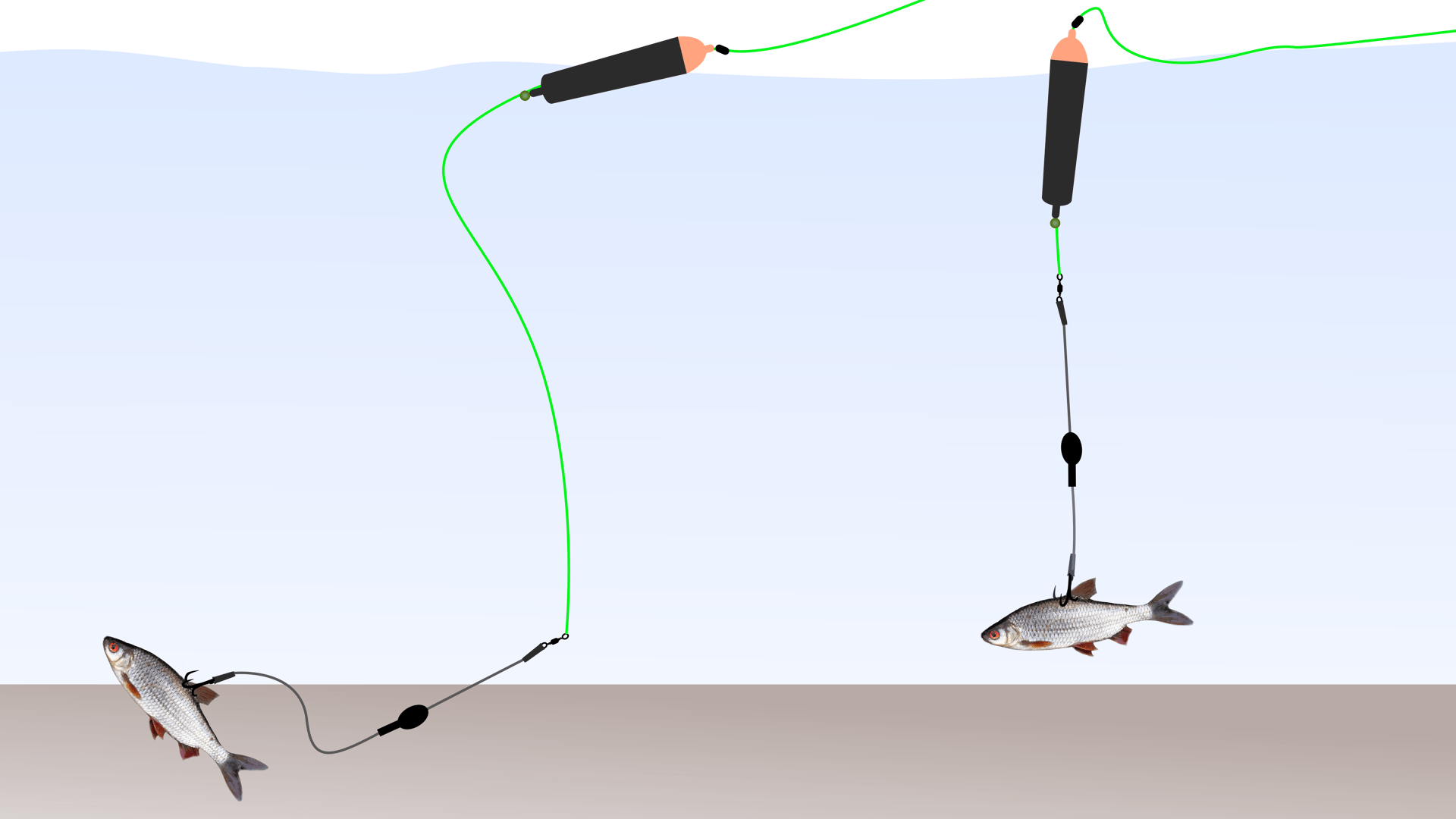
By sliding the float stop further up the line (bit by bit on successive casts), at some point the float will lie flat on the water. This shows when the bait (and possibly the sinker) is laying on the bottom. At that point, just retrieve enough line to create tension between the rod and the bait (this will cock the float – much like in the classic lift method).
Drift Float Dead Baiting
Suspending the bait is a good way of covering water when you drift the float using either the flow of water or the wind (you can even buy specialist drift-floats with vanes attached for this method). For large, windswept lakes and reservoirs – drift-floating can be an incredible method. As well as the vane (to catch the wind), the other important element of a drift float is the controller arm (or boom). See the following diagram to get an idea of how this modification to standard pike float fishing works:
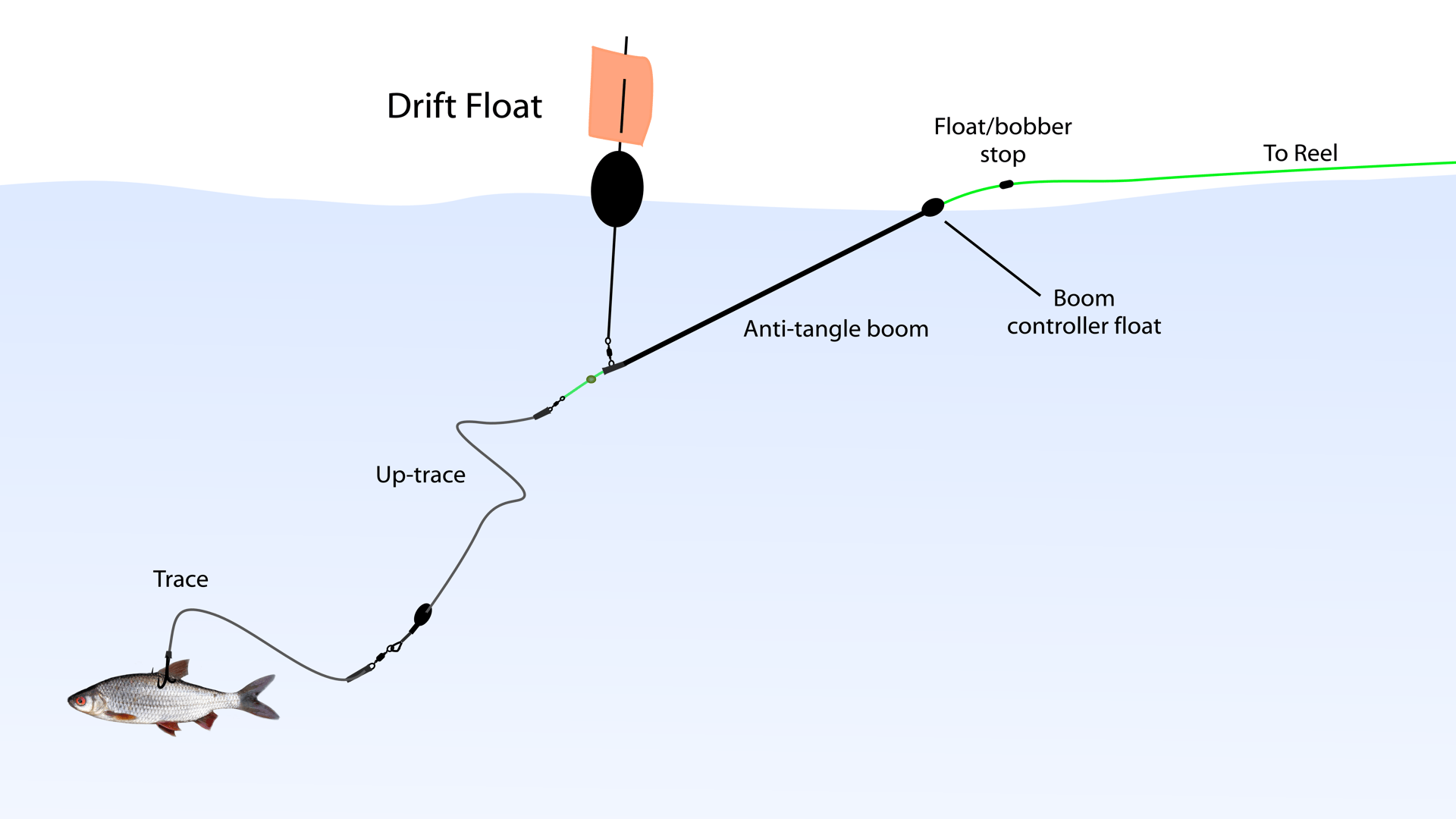
The up-trace and bait-mount trace are the same as shown for the float-leger rig. The reel line is threaded through the anti-tangle boom and tied onto the up-trace.
Legering with Dead Baits
With a simple modification to the rig, it is easy to switch out the float for a ledger (or leger) rig. This will start with an up-trace (for the reasons mentioned already), with the swivel of the trace attached to the reel line via a Palomar knot – just as we had for the float rig. A super important point to note is the use of the run ring which is large enough to pass over that swivel. The run-ring is clipped to your weight – which is likely to be pretty heavy (say in the 3 to 4-oz range). If your run ring is too narrow to pass over that swivel, then any breakage of your reel line could potentially leave a pike tethered to that heavy leger weight.
Here is the rig diagram to follow:

Having a buffer bead between your run-ring and the quick-link swivel that your bait-trace is attached to will prevent the leger weight from sliding down onto your bait during casting. The trace and hook-mounts for your dead bait will be the same as that described for your float fishing.
As a bonus tip, replacing the leger weight with a heavy feeder can help to attract shoals bait-fish which will help to draw in a prowling pike to the area where your dead-bait is fishing.
By far the most common (and very effective) way to mount a legered dead-bait is to hook one point of the top treble through the tough tail-wrist of your bait – with the bottom treble hooked into the back or flank of your bait. Basically the same mounting style works just as well for eel and lamprey sections as well as the front half of a mackerel – with the idea that a pike wants to turn and engulf a bottom-fished bait lengthways, rather than crossways.
When legering, the bait can be left at its natural buoyancy - or it could be "popped up" from the bed by using a buoyant foam ball or chunk of foam. If a single hook is used as the "top" hook (and/or if your bait has a slightly more delicate tail wrist than some of the tougher species) - then using bait elastic to lash the hook shank securely in place is a good idea.
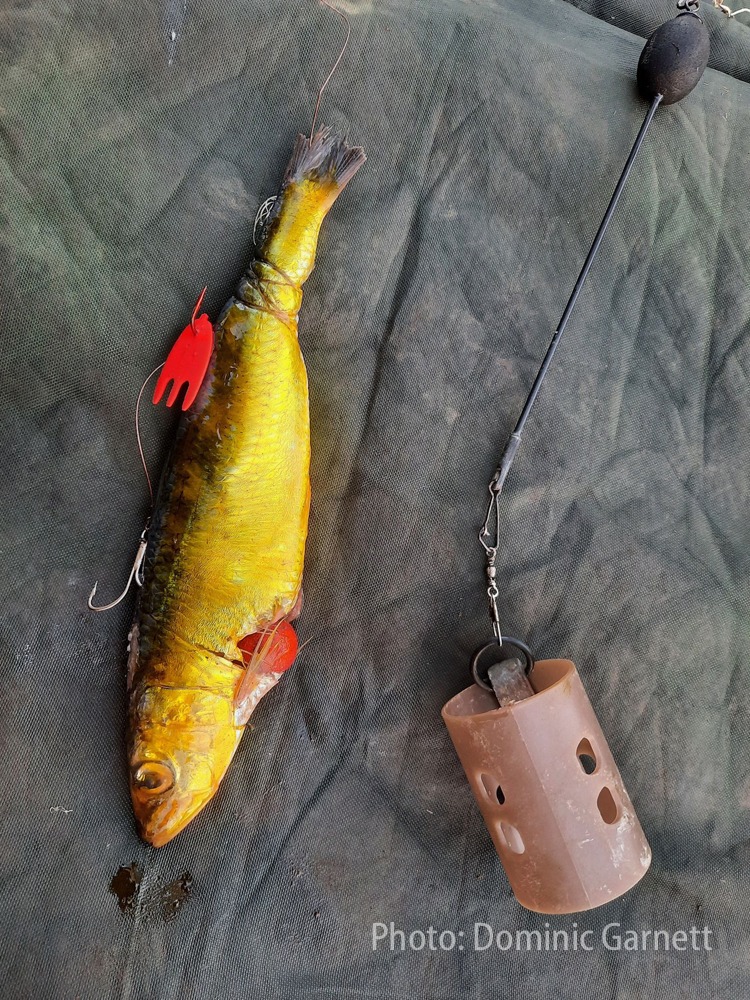
Dom Garnett with a full "bag-o-mashings" approach of coloured deadbait, popped up with foam - along with a red-coloured top hook (lashed on with elastic and further highlighted with a red bait flag. The whole thing is topped off with a feeder to be packed with groundbait/loose feed to attract bait fish (and, in turn, draw the pike in)
Indication of runs while legering deadbaits for pike is a little different from all other methods of pike fishing. You need to have indication whether the fish comes towards or away from you, and a so-called drop-off indicator can be combined with your heavy leger-weight/large run-ring and a regular carp-fishing bait alarm to achieve this.
With that heavy, but freely-running weight – as long as you tighten down to your weight before setting up your indicator – the run-ring will act like a pulley and the line will be drawn away from you. This is true even if the pike runs towards you with the bait.
Another good thing about using a drop-off indicator is that they are designed to be fished with an open bail-arm – which can allow you to use your Big Pit reels even if they don’t have a “bait-runner” style system. The position of the drop-off indicator means that it holds line on the spool when it is hanging on the clip directly below that spool. As line is pulled out of the clip, the indicator “drops off” and line can run freely from the spool. As that line pays out, your bank-stick-mounted bait alarm will sound and alert you to pick up your rod.
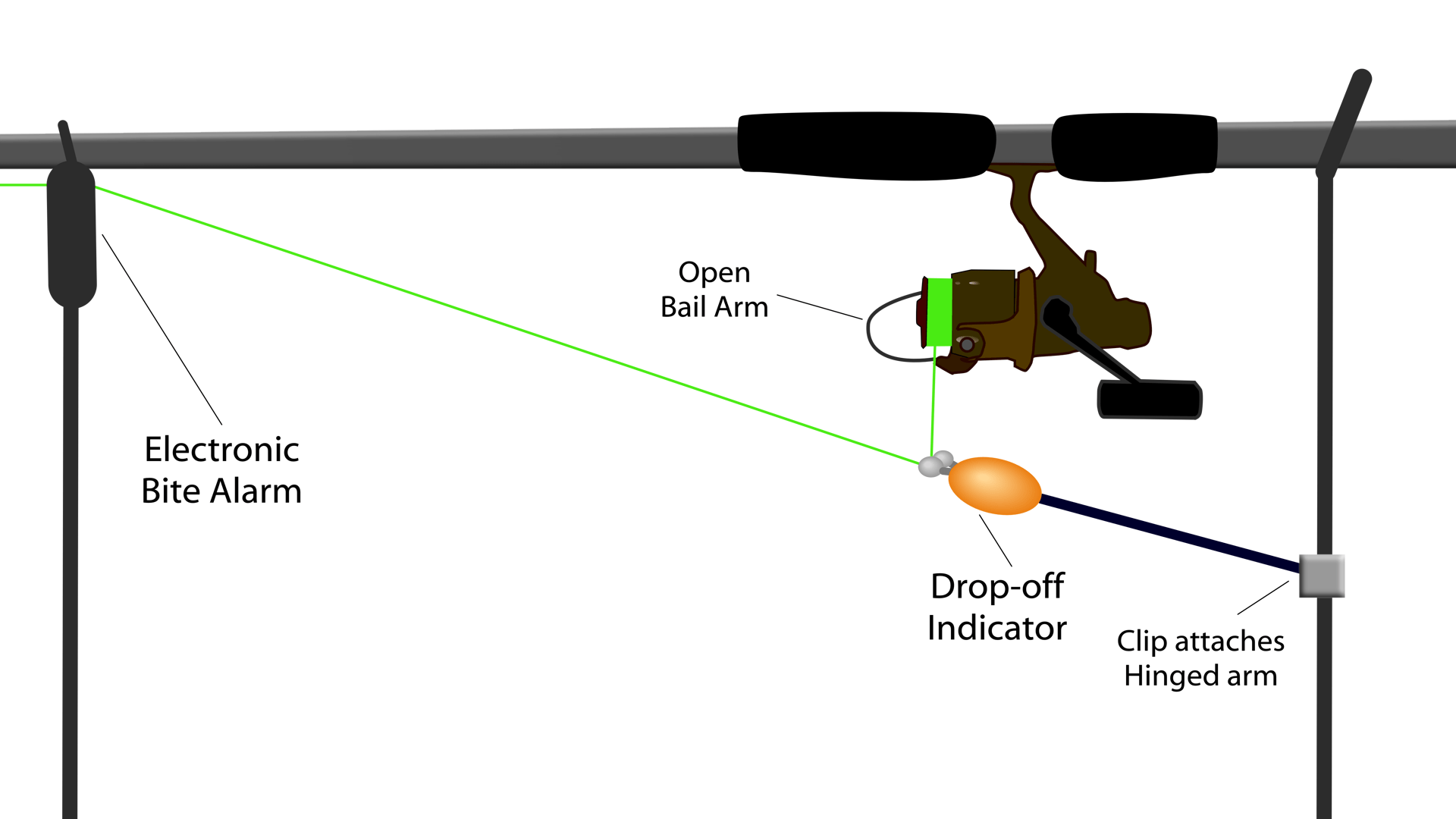
Drop off indicator and electronic bite alarm set up on rod-rests - with line clipped into the drop-off indicator
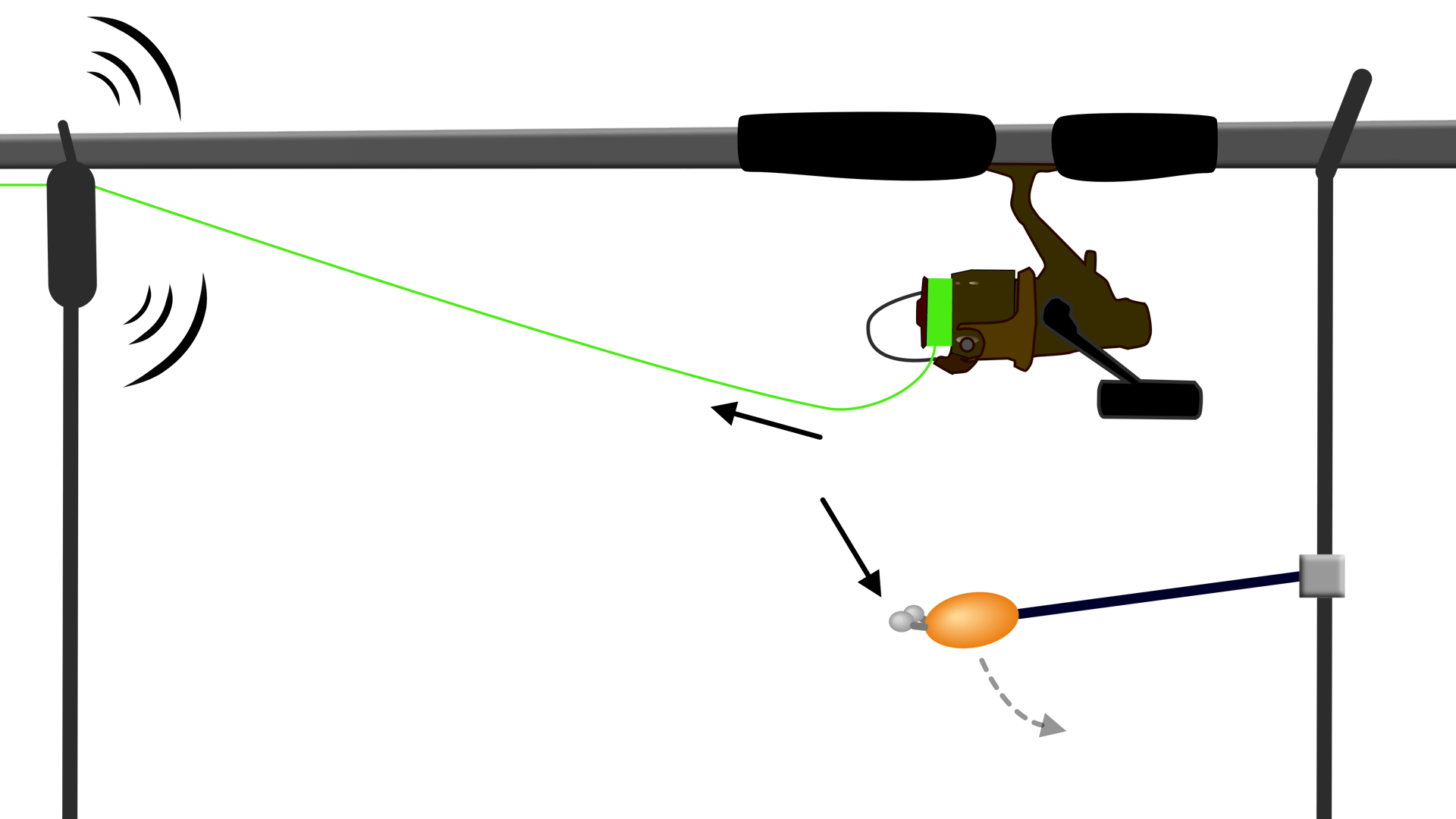
When a run develops, the reel line pops out of the clip and, if necessary, can pay out from the spool (while the alarm sounds)
With the rod picked up out of the rests, feeling the line between thumb and forefinger will tell you if you have an active run. If so, you can close the bail-arm and wind down to strike the fish as described for float fishing. Again, you should avoid leaving that run to continue for an excessively long time and risk the pike swallowing your bait. As soon as you have positive indication of your fish running away with the bait, then it is time to wind down and set that hook.
Additives for Pike Dead Baits (Plus Other Tricks)
There are a range of additives – both for scent and colour – available for pike fishing dead baits. Often, coloured additives also included an element of scent as well. As you probably know, the fish you choose for dead baiting will vary in how oily they are (with mackerel being much more oily than roach for instance). However, the really characteristic “fishy” smell of each dead bait will have a strong link to the particular mix of amino acids present in that fish.
Scents
Amino acids are the building blocks of proteins (rather than fats and oils). Amino acids contain a lot of nitrogen. When nitrogen-rich substances break down, they often have a pungent smell (think of ammonia for instance). However, the fresher a fish is, the higher the proportion of those intact amino acids (rather than ammonia and other breakdown products). It is also common, of course, to use oil as a carrier for those amino acid scents… I expect the chemistry of how the various ingredients are accommodated in the water where you are fishing will be quite complicated!
There are many options on the market - including the example below using my Amazon associates link (which doesn't affect the retail price, while creating a small commission to support Fishing Discoveries, with my thanks).
However, it is enough for us to know that these products are available and easy to use and that characteristic blends of amino acids are probably a good cue for a hungry predator on the lookout for prey fish to eat.
Therefore, particularly for slower or more static presentations often associated with dead-baiting tactics, adding extra scent can help a pike home in on your bait. It may also make it more attractive compared to any natural food in the area you are fishing (or even compared to any nearby anglers’ baits!).
With special "sticky", super-concentrated additives such as the example above, it is also possible to use these as part of your lure-fishing approach...
Colours

Coloured dead bait mounted horizontally for float fishing (as described previously) by Dom Garnett at https://dgfishing.co.uk/
With coloured additives, the idea is to make your bait more conspicuous and potentially more attractive. With that in mind, it makes perfect sense for coloured additives to also contain amino acid scent ingredients too.
Application
If you choose to use any bait additives – whether purely scent or combined scent and colour – then you have a choice of how to apply them. Spraying on the outside of your baits is probably the simplest and most direct option. By applying it to the outside of your bait, the colour will be very obvious (e.g. above) and also the scent will rapidly be released to start doing its work.
As an alternative, injecting your bait will give a slower and (probably) longer-lasting scent trail. That approach can also give a different application of colour as a slowly-leaking cloud to lead a pike to your bait. However, the careful use of a hypodermic needle and syringe is not only handy for injecting scent and colour...
Using a Syringe to Create “Pop-ups”
Legered baits that sit up a little way off the bottom can be essential when fishing over either weed or a silt beds. Popping a bait up so it hovers just above the soft bed material prevent your bait being smothered and hidden. Even on a relatively hard bed, a popped-up bait can give you an edge over one lying hard on the bottom.
So far in this article, the use of foam has been shown as a way to create popped-up baits. However, another great way to achieve this is to carefully inject some air into the body cavity of your deadbait after mounting it on your trace.
NOTE: Over time, the air may leak out – so it is worth doing a quick “drop test” between casts to find out. Just drop your rig in the margins at your feet where you are fishing to see how your bait is behaving.
If necessary, you can top up the air or, eventually, swap it out for a fresh bait.
Perhaps it doesn’t need saying, but I’m going to anyway – TAKE CARE when using hypodermic needles. A very easy mistake to make is to use a hypodermic needle on your lap, without having a hard surface under your bait (e.g. a tray) to protect your legs while you inject. On cold days, your fingers won’t work so well, and this can also lead to accidental needle-sticks. Take your time and set yourself up for safe-use rather than accidents.
Hair rigging with BIG single "circle" or single hooks
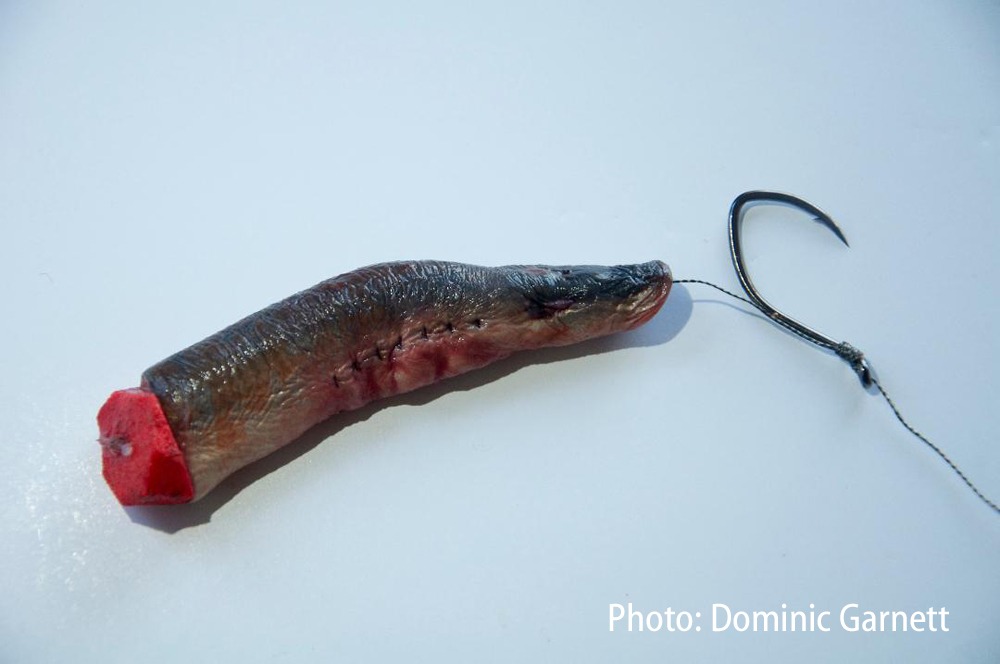
Lamprey section mounted on a hair rig using incredibly supple wire/kevlar braid
The use of products such as Cannelle Supratress (Amazon associate link below the video if you want to check it out) allows you to mount a deadbait onto a flexible - but bite-proof - trace via a classic carp-fishing hair rig and knotless knot. First of all, here's how to create a hair rig using the knotless knot:
By making this hair rig with Cannelle Supratress, you can create a flexible trace which ends in a quick-link and can be clipped onto your line/uptrace as for previous legering rigs.
Using a baiting needle with a chunk of foam already threaded onto it, you can thread your bait onto the needle and then pull the loop of the hair through both the bait and the foam chunk. Inserting a "boilie stop" into the loop and pulling the hair to snug the loop down onto it will secure your bait for casting.
Lure Fishing for Pike
As well as the essential foundation skills covered in the FD lure fishing article, here are some pointers to get you off to the races when lure fishing for pike. Options (and my preferences) for rods reels and main lines have already been covered in this article – so that leaves us free to concentrate on rigs, lures and tactics. As mentioned already, you shouldn’t be scared of throwing a large lure even for small pike.
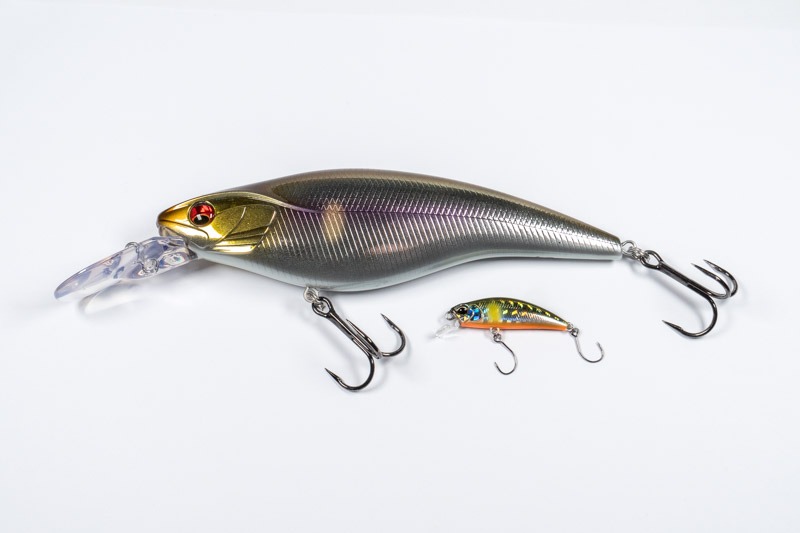
This is not to say, of course, that they won’t also take small lures – even big pike have been known to take tiny insect larvae! In fact, in some conditions going really small with your lure (maybe during extremes of either hot or cold weather – or perhaps on more pressured water) can get you a bite when standard size pike lures are ignored. I recently caught a jack of around 8-lb on a freezing cold day after throwing everything else in my box at the fish. The only fish of the day – and it took a 2” (50-mm) spiky shad fished simply on a 3-g jig head and crawled/hopped slowly along the bottom.
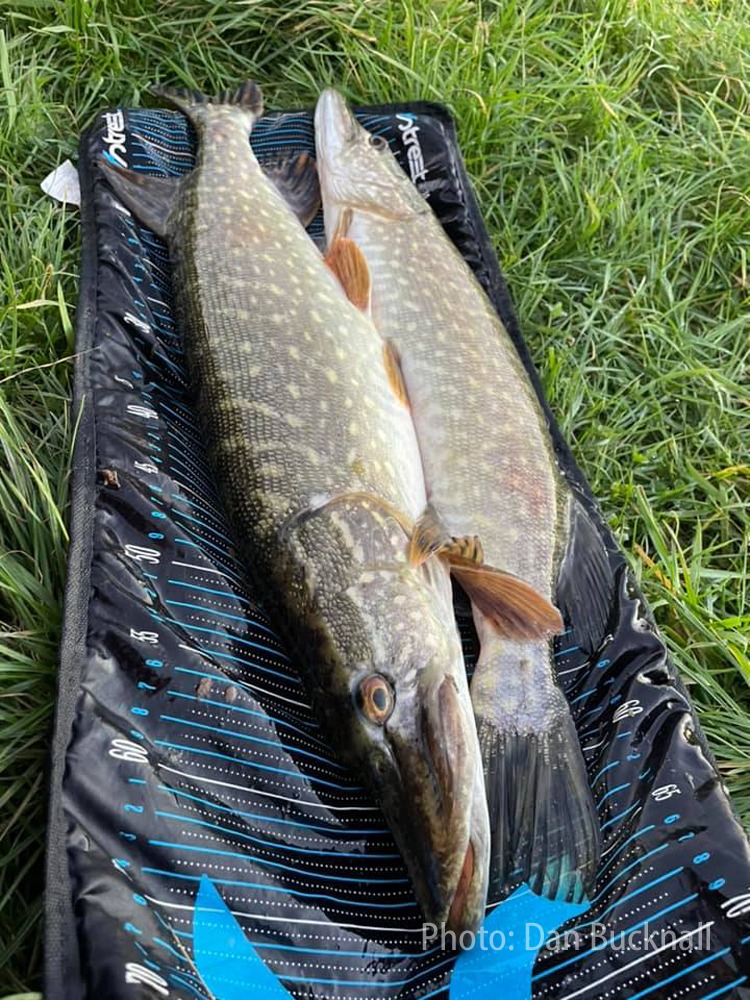
A pair of lure-caught pike by Dan Bucknall (Insta: @db_fishing_)
Look out for my article on the best bite-proof traces for finesse lure fishing for the inside track on that ultralight gear.
With all that said, as a very (very!) general rule, going for lures that are that bit larger than you’d use for other fish species of a similar weight is not a bad guideline for pike fishing.
Simple rigs when Lure Fishing for Pike
The usual bite-proof trace is mandatory – and it’s your choice as to whether you use titanium or steel. However a growing number of anglers are happy to use 50, 80 or 100lb fluorocarbon as a bite-proof trace when lure fishing. One further consideration is that, while braided titanium is often preferred (allowing more action across a wider range of lures) – the stiffer single-strand titanium can be useful for things like large glide-baits (and can also help avoid the belly treble from fouling around your line while casting).
Whatever your trace, having it terminate in a quick-link is an effective and convenient option. Then it’s just a case of experimenting with lures to clip on the end!
Where to start with tactics?
For getting confidence and a great sense of how to approach lure fishing for pike, check out any of Dan Bucknall's pike fishing videos on his YouTube channel "DB Fishing".
Keeping things as concise as possible (I’d like to expand this section into a standalone pike lure fishing article), here are some handy guidelines to help improve your chances when you’re just starting out. As you will hear me say many times (without apology), the most reliable path to success is to try to understand what the fish are looking to eat – and then work backwards from there to plan your approach. This means understanding a bit about pike behaviour.
Location
First of all – try to find out where the biggest density of prey is likely to be. As long as it isn’t a freezing cold wind, prey fish (and the stuff they feed on) will often be concentrated on the down-wind bank of lakes, reservoirs, bays and slow-moving rivers/canals. In very cold winds, prey fish can sometimes gather on the upwind bank. This usually happens if the cold wind-blown surface current tucks under when it hits the downwind bank and flows across the bed, back towards the upwind bank.
Regardless of wind temperature or direction, If you’re lucky – a pike might give the game away by attacking a shoal of baitfish and causing them to scatter on the surface. That’s a great chance for you to get some clues on how to “match the hatch” (in terms of size and perhaps colour) as well as the location of a feeding pike.
Pike Behaviour
As with many predators, pike frequently have definite active and dormant spells throughout the day. The challenge here is that you can be fishing exactly the right bait with exactly the right movement – only for the fish to be lying dormant on the bottom. Yet, ten minutes later that same fish might switch on and take another angler’s lure in the same spot you just fished.
Again, generally speaking, a sensible starting point is to guess that the colder the weather, the slower and closer to the bottom you should run your lure. The flip side of this is that fishing the upper layers in warmer weather often means that any deep laying pike are happy to charge up through the water to hammer a bait fished mid-water or closer to the surface.
A similar rule of thumb with regard to temperature is that (as a starting assumption which you can change if necessary) colder water means slower retrieves. There are always exceptions of course, but having no idea where to even start is an overwhelming and un-enjoyable experience.Keeping temperature vs depth & speed in mind will help you home in on the kinds of lures that will support those presentations (hard baits often come with an indicative fishing depth for instance).
Matching Approach to Behaviour
For sinking baits (including soft plastics mounted on various weighted rigs), you should get a sense for how far they will sink when left to fall through the water by trying them in the margins before casting them with full intent. Using the tried and tested “count down” method when using sinking lures will help you to reproduce any attacks you get at particular feeding-depth(s). Surface lures, well, they kind of speak for themselves.
Fishing your lure around the features that ambush predators (including pike) love is also another core skill. Submerged structure such as weedbeds (whether dying back in winter or in full lush growth), lay-down limbs/trunks of trees, rocks, moored boats, reeds/grass and other emergent banks, boat-docks, fishing platforms etc. etc. are all vital signs to read.
Noticing how snaggy those features are will naturally guide you on how risky it is to fish exposed treble hooks (versus a sliding-scale of weedless rigging options on single hooks). It should also guide your choice of reel-line and trace-strength.When all is said and done, it isn’t about knowing in advance what the perfect bait will be – but to have a few structured choices based on the conditions. That way, you can cycle through several options and find out what the pike want on a particular day.
Paralysis by analysis will stop you either catching or enjoying lure fishing for pike – and the lure that stays in the box has a 100% certainty of NOT catching a fish.
In boxing terms the advice would be to "go out there and throw some leather"...
Fly Fishing for Pike
A lot of the advice for lure fishing (in this article and in the general lure fishing article) will also apply to fly fishing for pike. After all, the aim of the game in both cases is to convince your target fish to attack an artificial lure as if it is a real bait fish. Similarly, the idea of matching presentation depth and speed to the water temperature (and likely behaviour of the pike) are also common factors. The main difference is how those effects are achieved when using fly gear.
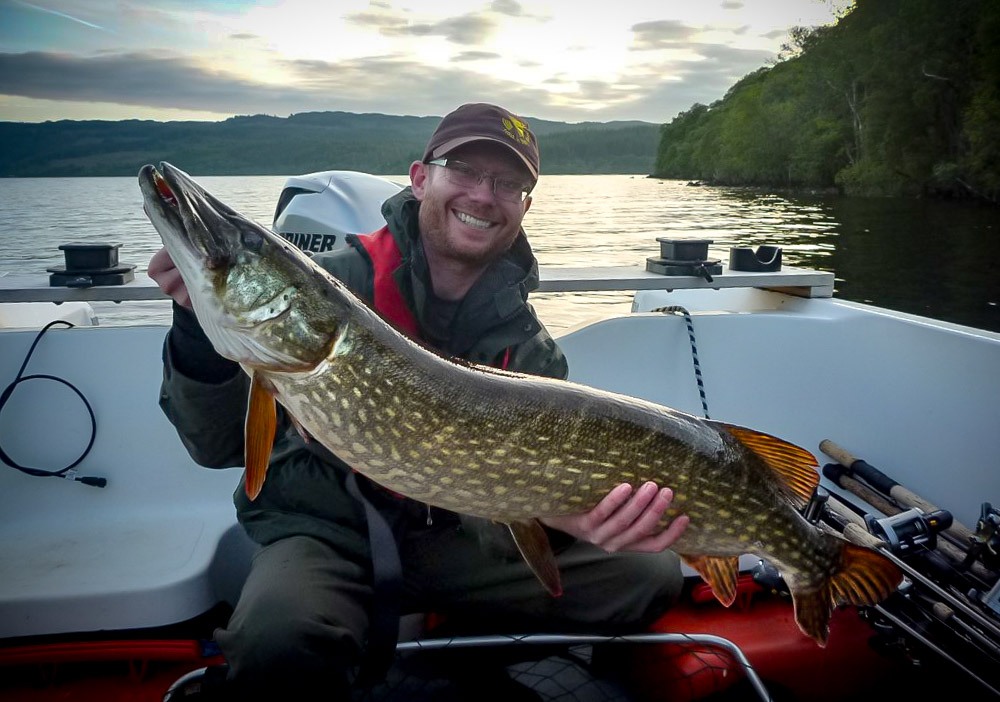
My PB fly-caught pike (estimated at between 22lb and 26lb in the absence of scales) resulting from Alan Kettle-White's immense local knowledge
There can be significant advantages to the effects you can achieve when using fly tackle for pike. At the same time, there is also likely to be a reduced casting range compared to throwing a large swimbait on a baitcaster and powerful rod. Distance isn't everything though - particularly when fishing shoreline features or fishing from a boat.
Ways to control, monitor and understand presentation-depth with fly fishing gear are given detailed coverage in the Fly Fishing for Stocked Trout article.
The degree of shimmering "living flutter" possible a pike fly is unmatched even by soft plastic baits - and soft plastics usually have a pronounced sinking action (which can be very good). As a change-up option, the near-neutral hang/slow sink behaviour of a fly coupled with all that inherent action can be a very successful combination. Even with jig-flies or cheburashka-rigged flies, that presentation is very different and much more "sink and draw" compared to the flat trajectory of a fly-line presentation (whether that is a floating or sinking fly-line).
Another potentially significant ability you have with a floating fly line is the ability to throw large "mends" across the water. In this way, it is possible to swim the fly parallel to a feature on the opposite bank of a canal (for example) and then have it turn a corner and swim across the channel at 90-degrees. That isn't something you can do with braid or monofilament when lure fishing.
The seemingly impossible result of having fly anglers winning a "Fly versus Jerk" competition (showcased by KanalGratis.se) has even happened before now:
Alan Kettle-White (Argyll Fisheries biologist and "Ferox" trout addict) who put me onto that big fly-caught pike pictured above is firmly convinced that fly fishing is his most successful method for big pike on Loch Awe. The willingness of fish to rush up from below and hammer a relatively shallow-fished fly is very noticeable. When the fish in the photo grabbed the fly (a 7"-long, black rabbit-fur "leech" pattern fished on a floating line), a "plughole" vortex over a metre in diameter sucked the lake-surface down into itself as the fish turned savagely sideways...
Pike Flies
Martin Smith (@mscustomflies on instagram) has created and rigourously tested a range of pike flies that have, rightfully, developed a cult following. As well as tying them professionally to order, Martin also shares the methods for creating his patterns on YouTube.
The profile of patterns like the "Reaper" (and the fly demonstrated above) means that pulls and pauses on the retrieve cause the fly to kick out sideways just like a jerk bait or glide-bait in lure fishing. Presenting that side-on profile in the face of a following pike can often drive them crazy!
It is the use of synthetic and natural fibres in the creation of these baitfish profiles which provides not only the mobility - but also the super slow sink AND exceptionally light weight of even large-profile flies (important for casting on a fly line).
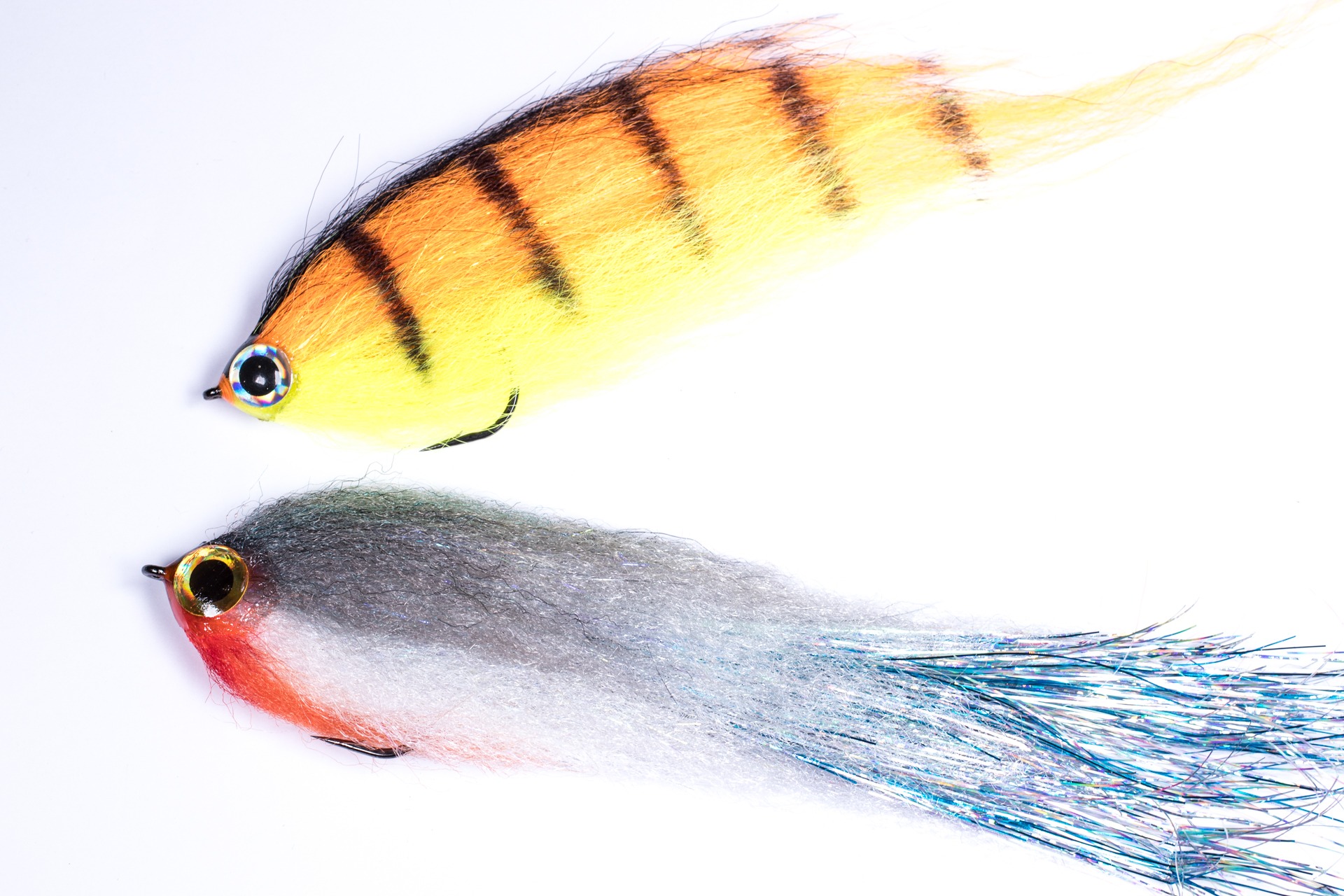
Synthetic fibre baitfish (top) and flashtail roach (bottom) both tied by Martin Smith (insta: @mscustomflies)
When using a floating line, the sink-rate of some fly patterns can be increased with the use of weighted dumbell eyes at the head of the fly - and/or the addition of sufficient epoxy coating at the head of the fly. However, combining either weighted or unweighted flies with different densities of sinking fly lines can also produce a wide variety of presentation depths and also retrieve profiles (from flat to undulating, depending on the sink profile of the line as well as the fly).

Reaper (top) and a Flashtail Whistler (bottom) both tied by Martin Smith
Density compensated fly lines sink in a much straighter line than standard sinking fly lines (or "sweep" lines), which tend to sink "belly first" and produce a more "U-shaped" sinking profile when viewed from the side. Shooting heads (with broadly neutral density braided backing) can also produce a flat retrieve profile.
There is also the prospect of using buoyant flies on either floating line (e.g. surface "popper" style) or sinking line ("booby" style) presentations. That latter approach uses buoyant foam to have the fly rise up above the level of the sunk line - and the fly is pulled downwards as well as across each time you retrieve line.
As you can see, the ability to combine properties of the fly line with properties of the fly open up a lot of different tricks that can be hard to replicate when using standard lures and lure-fishing lines...
River Pike Fishing
With a toolbox of tactics and rigs built up throughout this article, it is now much easier to pick out some advice for river pike fishing (and other venue types too as we’ll see). The ambush predator nature of pike means that they will tend to favour areas that are not particularly fast-flowing. Instead they like to lie up in and around structure and generally slower water. This means pools and slow glides will be the type of water you’d expect to find them.
Methods for Rivers
Reservoir Pike Fishing
The sheer size of reservoirs can be extremely daunting – especially when fishing from the bank. The use of a boat goes a long way to cutting reservoirs and large lakes down to size. That is particularly true when you also have electronics to show baitfish shoals, drop-offs and even your target fish.
However, with or without a boat, there are other ways to reduce that feeling of overwhelm…
Methods for Reservoirs
Canals
As well as conforming very well to the methods described for rivers in this article, it's also featured in the FD article canal pike fishing. Judging by content on YouTube, these waterways are enjoying a boom in popularity for pike fishing as well as for perch anglers. The great thing about canals is that, depending on the weather, they can be ideal for every single one of the methods featured in this article.You can treat them like a slow-flowing river or, in many cases, fish them using "stillwater" methods too. That is particularly true in the turning basins or marinas.
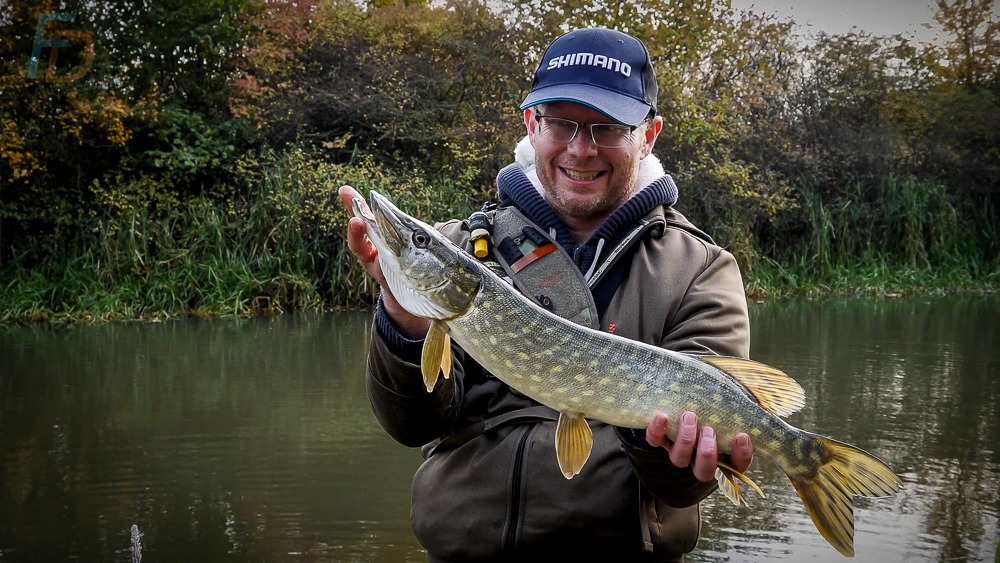
A bright, clean canal jack pike caught on the fly (in fact on the fly rod and reel featured in this article)
Methods for Canals
Northern Pike Fishing Round Up
I admit that it’s impossible to cover everything in a subject as rich and deep as pike fishing. Instead, the aim is to de-mystify just enough of the methods and venues to give you confidence to try something new. Becoming great at any one of the individual disciplines should take you several years – and there are plenty of disciplines to go at as you can see. However, the good news for everyone (including myself) is that you don’t have to wait to become great before you can enjoy fantastic, successful and memorable days on the water.
Why not get out there and give it a go?
Paul

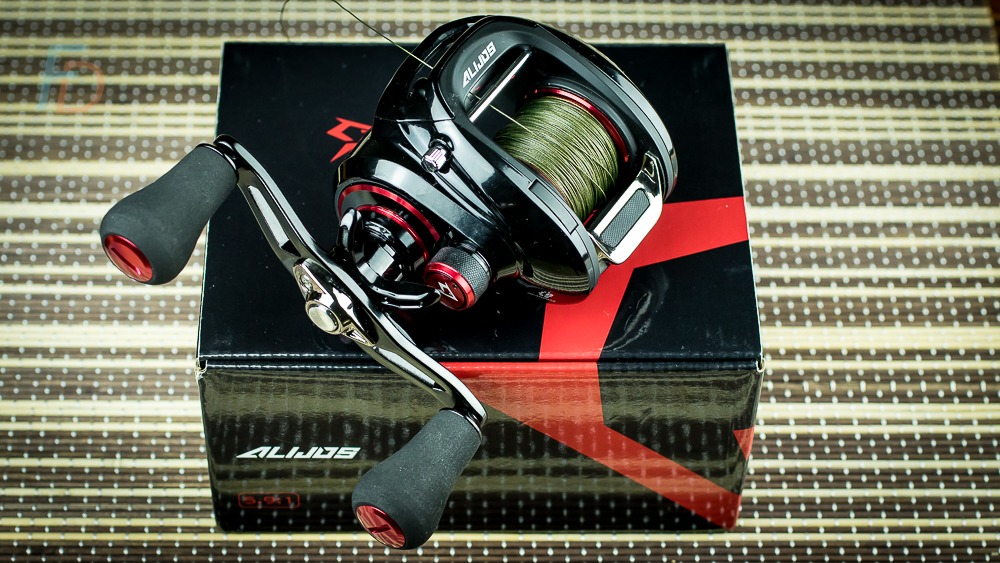



[…] If you’re looking to experience the excitement of pike fishing on a new venue – here’s a guide to targeting these “freshwater barracuda” on rivers, lakes, reservoirs and more… […]
[…] Pike Fishing: The FD Guide to Fishing for Northern Pike (Esox lucius) […]